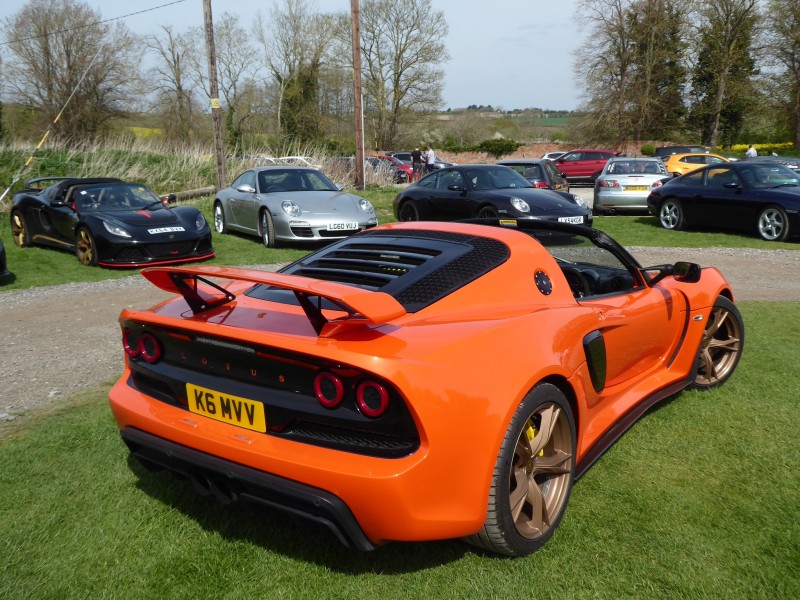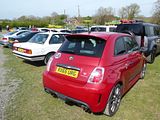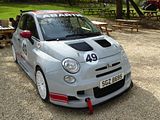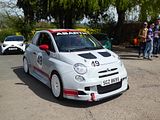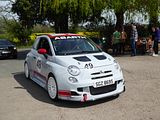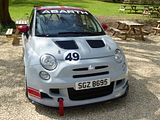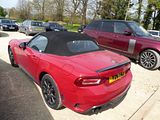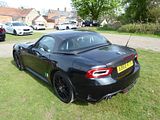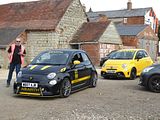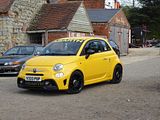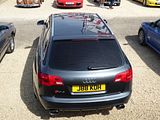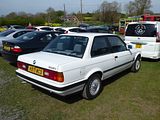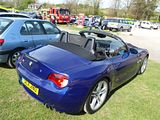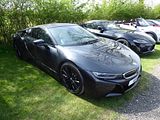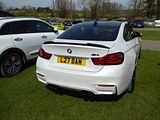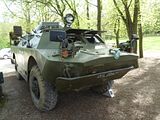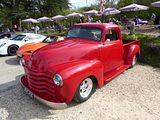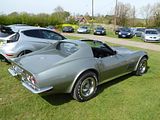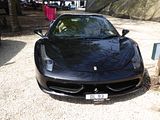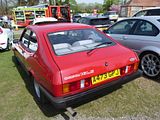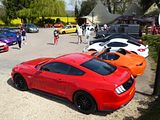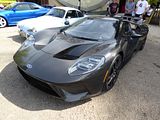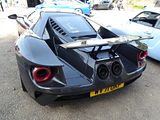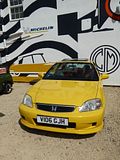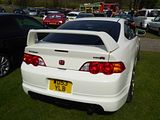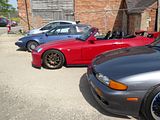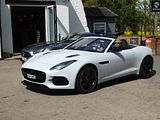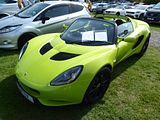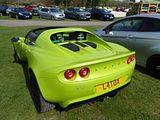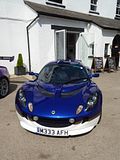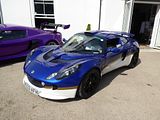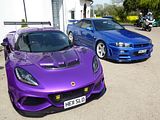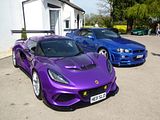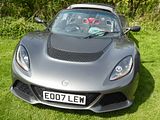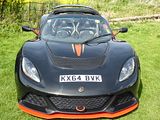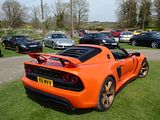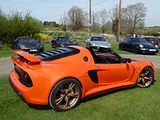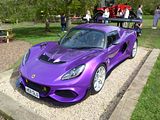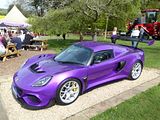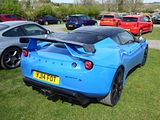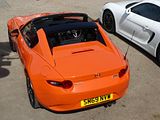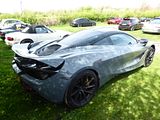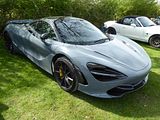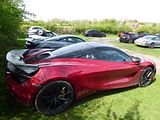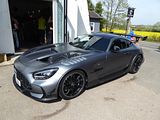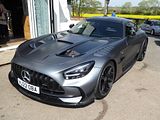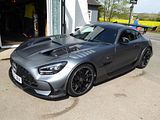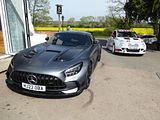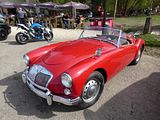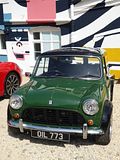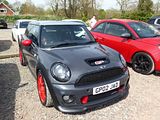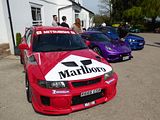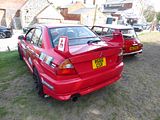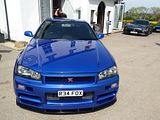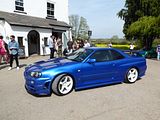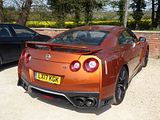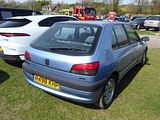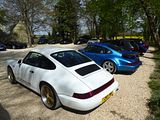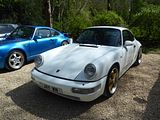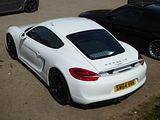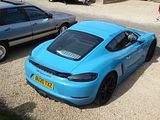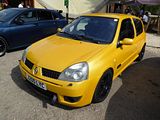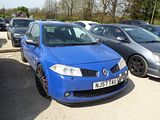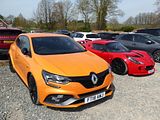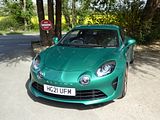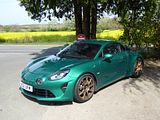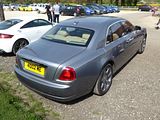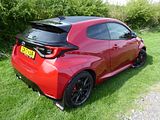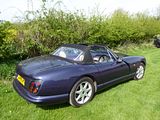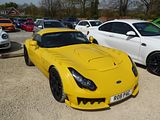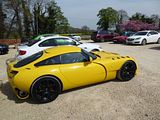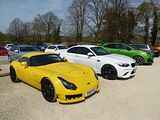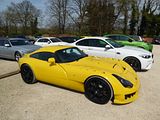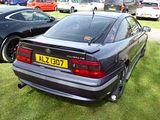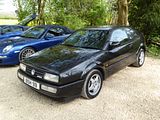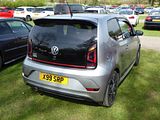After a number of visits to the ever-popular Caffeine & Machine in quick succession early in 2022, there’s been a bit of a gap, of more than two months, whilst my diary has taken me elsewhere in the country and out to the USA on holiday, but I always knew that it was only a matter of time before I would be back. With a need to be in the Daventry area early on Easter Monday for Abarth Spring Festival, calling for an overnight stay, then a visit to Caffeine & Machine not just for me but also any other interested Abarth Owners seemed to be a logical thing to schedule for the afternoon of Easter Sunday. Needless to say, we were not the only ones who wanted to visit, and tickets for the popular early afternoon slot sold out, so in the end we were not joined by as many Abarth Owners as you might expect, but that did mean that there were all sorts of other cars on site to see. And here are the ones that stood out for me:
ABARTH
Rumours started to circulate towards the end of 2014 that Abarth were going to upgrade the Competizione model, so as better to bridge the gap between the Turismo and the 190 bhp 695 Biposto that had been added to the range earlier in the year. It was Geneva 2015 when the result was finally shown to an expectant fan base. Most exciting news was that thanks to a bigger Garrett Turbo, the engine had been tweaked to 180 bhp, and with reduced CO2 emissions. A standard spec that included Koni Dampers, Brembo brakes, Xenon lights, Sabelt seats, Climate Control, parking sensors as well as other refinements that had been added like the TFT instrument display all proved very compelling, so not long after the first cars reached the UK in June of 2015, I found temptation too hard to resist, and as is well documented here, swapped my 2010 car for one of these. At the time I ordered it, Cordolo Red, a tri-coat pearlescent paint which shimmers in bright sunlight looked set to become one of the most popular colours of the lot, even though it is a cost option. Indeed, the Launch Edition models were all offered either in this colour or Scorpion Black, with black wheels. Surprisingly, the colour was not carried over to the Series 4 cars.
This is not so much modified as bespoke. It made its first appearance at a UK event last October, following acquisition by Abarth fan Dave Quinn earlier in 2021 and a long process to get the car so it could be road-registered . Effectively this takes its inspiration from the Assetto Corse race cars produced in 2010 and it has a Romeo Ferrari bodykit on it. Just two were created and the other one is in Italy. It attracted lots of interest at this event.
Eagerly awaited, the 124 Spider went on sale in September 2016. A quick reminder as to what this car is: The Abarth 124 Spider was developed in parallel with the Fiat model. It does cost a lot more, and there are those who think you don’t get enough extra for your money, but those who have driven it will tell you otherwise. You certainly get more power. The 1.4 MultiAir turbo unit jumps up from 138bhp to 168bhp, while torque also increases by a modest 10Nm to 250Nm, which gives it a 0-62mph time of 6.8 seconds, which is half a second quicker than the 2.0-litre Mazda MX-5. The top speed is 143mph. It weighs just 1060kg meaning a power-to-weight ratio of 158bhp-per-tonne, and with the new Record Monza exhaust system it sounds great even at idle. The Abarth version gets a stiffer suspension setup than the regular Fiat 124 Spider, with Bilstein dampers and beefed-up anti-roll bars. Bigger Brembo brakes also feature, with aluminium calipers. It can be had with a six-speed manual or six-speed automatic transmission with paddles, and the latter gets a Sport mode for quicker shifts. Many of the UK cars sport the ‘Heritage Look’ pack, which is a no-cost option. It brings a matt black bonnet and bootlid, plus red exterior trim detailing and has proved popular. The £29,565 starting price gets you standard equipment such as cruise control, climate control, Bluetooth, a DAB radio and satnav, plus Alcantara black and red (or pure black) seat trim. The automatic gearbox is a £2,035 extra, while an optional visibility pack brings LED DRLs, auto lights and wipers and rear parking sensors. As well as the standard car, there was an example of the GT.
With the 12:30 – 15:30 slot full, a couple of owners, Poppy Edgar and Mark Rosales ended up booking the 16:00 slot. They arrived just as we were leaving. only to be told that they were too early and were asked to go away for 20 minutes or so, which they did. Both have what are known as Series 4 examples of the 595. which arrived in the market in the middle of 2016. After rumours had circulated all winter following the launch of the facelifted Fiat 500 in 2015, Abarth finally unveiled the Series 4 at the end of May 2016. Initially, we were told that the cars would not be available in the UK until September, but that came forward somewhat, with dealers all receiving demo cars in June, and the first customers taking delivery in July. Three regular production versions of both the closed car and the open-topped C were initially available, all badged 595, and called Custom, Turismo and Competizione, as before, though numerous limited edition models have since appeared and in most case disappeared. The most significant changes with the Series 4 are visual, with a couple of new colours, including the much asked for Modena Yellow and a different red, called Abarth Red, which replaces both the non-metallic Officina and – slightly surprisingly – the tri-coat pearlescent Cordolo Red. as well as styling changes front and rear. The jury is still out on these, with many, me included, remaining to be convinced. At the front, the new air intake does apparently allow around 15 – 20 % more air in and out, which will be welcome, as these cars do generate quite a lot of heat under the bonnet. Competizione models for the UK retain the old style headlights, as they have Xenon lights as standard, whereas the Custom and Turismo cars have reshaped units. At the back, there are new light clusters and a new rear bumper and diffuser. Inside, the most notable change is the replacement of the Blue & Me system with a more modern uConnect Audio set up, which brings a new colour screen to the dash. Mechanically, there is an additional 5 bhp on the Custom (now 145) and Turismo (now 165 bhp) and the option of a Limited Slip Diff for the Competizione, which is likely to prove a popular option. Details of the interior trim have changed, with a filled-in glovebox like the US market cars have always had, and electric windows switches that are like the US ones, as well as a part Alcantara trim to the steering wheel in Competizione cars.
AUDI
The third generation Audi 100 launched in September 1982 with aerodynamic styling, contrasting the boxy styling of its predecessor, and offering a much improved drag coefficient, 0.30 on base model. The aerodynamic C3 bodywork featured pin-mounted flush windows, offering a key reduction in aerodynamic drag. Altogether, the aerodynamic body increased the fuel efficiency and top speed versus other cars of similar engine size. The C3 introduced Audi’s proprietary restraint system, marketed as procon-ten. Two-door models were no longer offered, and the Audi 100 Avant was now positioned as a station wagon rather than a hatchback – the Avant designation would be used for all Audi station wagons from that point forward. The Avant featured an available extra folding third row seat — not available in conjunction with ABS-brakes as the brake control unit sat in the same space. The 200, launched in 1983 continued as the upmarket variant with several versions of the 2.2 L turbo 5-cylinder available in different markets over its life ranging in power outputs from 165 PS MC engine, through the 200 PS versions to the final 220 PS 20-valve 3B engine available from 1991. The 1983 Audi 200 Turbo had a top speed of 139 mph (224 km/h). The MC turbo engine was available in the 100 as well for some markets. In January 1988 the Audi 100 received a minor facelift, including flush fitting door handles. The 1991 200 20V featured flared (vs. flat) front and rounded rear wheel arches to accommodate wider wheel and tire combinations to be fitted to 20V models. U.S. magazine articles of the period reported 0-60 times of the 20-valve Audi 200 under 7 seconds, with 1/4 mile times in the mid to upper 15 second mark. The Audi 100 also featured a 2.5 L straight-five direct injection turbo-diesel (TDI) model with 120 PS introduced in January 1990 (engine code 1T). This was the first model to wear the TDI label. It had a brief career in the C3, being replaced in December of that year when the C4 arrived. 1991 was the last year for the Audi 200, with the Audi V8 having replaced it as Audi’s top model.
The second-generation RS 6, (Typ 4F) was based on the Volkswagen Group C6 automobile platform and was launched in September 2007 at the Frankfurt Motor Show. The RS 6’s 4,991 cc V10 engine produced 579 PS (571 bhp) at 6,250 to 6,700 rpm and 650 Nm (479 lb⋅ft) of torque from 1,500 to 6,250 rpm, 71 PS and 150 Nm more than BMW’s 5.0L V10. As of January 2010, the RS6 was Audi’s single most powerful car ever, and positioned the car ahead of its closest competitors, the BMW M5 and the Mercedes-Benz E63 AMG in terms of engine output, both of which have naturally aspirated engines. However the estimated price of the RS 6 sedan in 2010 was $160,000 USD (another source quotes $126,000 USD in 2009, making the RS 6 perhaps too expensive for the United States market which set it apart from the performance variants of other executive cars: the MSRP of BMW M5’s was $85,700 USD, of Mercedes-Benz E63 AMG’s was $87,700 USD, and of Audi’s own S6 was $78,025 USD. Official performance figures for the Avant: 4.6 seconds for the 0-100 km/h (62.1 mph) sprint, 12.7 seconds 0-200 km/h (124.3 mph), and top speed is electronically limited to 250 km/h (155.3 mph), with a factory option to de-restrict the top speed to 274 km/h (170.3 mph). In standard form, CO2 emissions are rated at 333 g/km. The saloon reaches 0-100 km/h (62.1 mph) in 4.5 seconds. The C6 RS 6 Avant was launched in April 2008, and the four-door saloon/sedan was available from August 2008. Constructed from steel in a monocoque (unibody) design, the RS 6 uses lightweight aluminium for its front wings (fenders) and bonnet. Visually, the RS 6 differed from the related S6, having flared front and rear wheel arches (fenders), harking back to the original Audi Quattro, to allow for a wider wheel track. It also had no front fog lights to allow for larger frontal air intakes (for the two side-mounted intercoolers (SMICs), and additional radiators). The ten (per side) front light-emitting diode (LED) daytime running lights (DRLs) are located within the main headlamp housing on the RS 6 in order to increase the size of the air intakes, whereas similar LEDs (but five per side) on the related S6 are found adjacent to the fog lamps in the lower front bumper. LED lighting technology was also used in the rear lights. The RS 6 also included adaptive headlights, which swivel around corners in conjunction with steering wheel movements. The facelifted Audi A6, released as a 2009 model, received similar front and rear-end LED lighting styling to that pioneered on the RS 6. Luggage capacity, measured according to the VDA ‘block method’ in the Avant ranges from 565 litres (19.95 cu ft), to 1,660 litres (58.62 cu ft). The engine (parts code: 07L, identification code: BUH) of the RS6 was what Audi claimed to be the first all-aluminium alloy even firing 5.0-litre 90° V10 twin-turbocharged (“biturbo”), Fuel Stratified Injection (FSI), with a dry sump lubrication system. This engine is related to the naturally-aspirated V10 found in the Audi R8, S6 and S8, but the RS 6’s engine has around 400 unique parts. The engine has four valves per cylinder, with chain-driven double overhead camshafts, and variable valve timing for both inlet and exhaust camshafts. Charged intake air is cooled by two side-mounted intercoolers (SMIC)s. The engine is controlled by two Bosch DI-Motronic MED 9.1.2 engine control units, which act as ‘master’ and ‘slave’: two ECUs are required due to the high revs the engine can achieve. It also uses mapped direct ignition system with ten individual direct-acting spark coils, an electronic drive by wire throttle (Bosch “E-Gas”), cylinder-selective knock control, and cylinder bank adaptive lambda control, utilising eight lambda sensors. A total of seven radiators and four electric cooling fans are needed to cool the engine and related components under the aluminium bonnet of the RS6. Drive output passes through a ZF 6HP28A six-speed tiptronic automatic transmission. The gear ratios are: 1st: 4.171, 2nd: 2.340, 3rd: 1.521, 4th: 1.143, 5th: 0.867, 6th: 0.691, with shortened shift times, with “Dynamic Shift Programme” (DSP) and “Sport” mode. It has paddle-shifts mounted behind the flat-bottomed steering wheel, similar in design to the Audi B7 RS 4. The gearbox is set by default, in conventional automatic mode, to delay up-changes during acceleration, and change down earlier to maximise engine braking. Downshifts in all modes of operation include the Powertrain Control Module electronic control unit (ECU) “blipping” the Bosch “E-Gas” drive by wire throttle, for smoother shift shifts. The hydraulic torque converter includes a lock-up function in all forward gears and is able to completely disconnect when the vehicle is stationary, thus saving fuel. Like all Audi “RS” models, the RS 6 is fitted with Audi’s ‘trademark’ Quattro permanent four-wheel drive as standard. This version of the RS 6 uses the latest asymmetric dynamic 40:60 front-to-rear default torque distribution from the Torsen T-3 ‘automatic torque biasing’ (ATB) centre differential. This latest incarnation of the Torsen Quattro, first seen in the B7 RS 4, can automatically dynamically apportion up to a maximum 100% torque to the rear axle, or up to 80% to the front, dependent on traction conditions. The front and rear final drives are conventional “open” differentials (ratio 3.317) and use the Audi “Electronic Differential Lock” (EDL). EDL is a part, or “function”, of the Bosch ESP 8.0 Electronic Stability Programme, which also includes “Anti-Slip Regulation” (ASR) traction control system. EDL does not ‘lock’ the differential in a traditional sense, but uses electronics to compare the speeds of the two wheels on an axle, and brakes any wheel that is sensed to have lost traction (by rotating faster than the opposite wheel, beyond normally accepted deviations). This braking of a slipping wheel has the effect of transferring torque across the axle to the other wheel, which is assumed still to have traction. Like the previous RS6 and the B7 RS 4, this generation of RS 6 includes Audi’s “Dynamic Ride Control” (DRC) Sports suspension system. The system is mainly mechanical, using a pump to provide additional pressure in the diagonally linked dampers (shock absorber) during cornering, to counteract rolling and pitching. The system can dynamically adjust the stiffness at each damper constantly to maintain both a comfortable ride and a high grip. In this version, it has a three-way level control, selectable from the Multi Media Interface controls. The steering system includes rack and pinion speed-dependent “servotronic” power steering, with a ratio of 12.5, and a turning circle of 12.2 metres. The standard brakes on the RS 6 are cross-drilled, radially vented, and floating iron discs. At the front they are 390 millimetres (15.35 in) diameter and 36 mm (1.417 in) thick, clamped by gloss black six-piston fixed Brembo monoblock alloy calipers incorporating the “RS” logo, and at the rear they are 356 mm (14.02 in) diameter and 28 mm (1.102 in) with black single-piston floating calipers and an integrated electro-mechanical parking brake linkage. The parking brake serves doubles as a full emergency brake whilst the car is in motion, by applying maximum braking effort to all four wheels, resulting in activating the Anti-lock Braking System (ABS). Optional “Audi ceramic” Carbon fibre-reinforced Silicon Carbide (C/SiC) composite front brakes are available, only with 20-inch wheels, which use 420 mm (16.54 in) diameter by 40 mm (1.575 in) thick drilled, vented, and floating SGL Carbon composite discs, with grey painted eight-piston fixed Alcon monobloc alloy calipers with the “Audi ceramic” logo. Irrespective of the type of disc construction, all brake discs are mounted via high strength steel mounting pins which connect the ‘working’ surface of the disc to lightweight alloy disc hubs. A specifically ‘tuned’ “sport-biased” Bosch ESP 8.0 Electronic Stability Programme is standard, and includes Anti-lock Braking System (ABS) and Electronic Brakeforce Distribution (EBD), and Brake Assist (BA). This ESP system has three user-selectable settings: “ESP-on” – the standard default full protection mode, “ESP-sportmode” (which turns off the ASR and EDL traction functions), and “ESP-off” (which fully disables all ‘stability’ and ‘traction’ related functions). Standard wheels (in the UK) are 9.5Jx20-inch ‘5-segment-spoke’ design alloy wheels running on 275/35 ZR20 102Y XL (eXtra Load) tyres (rated at 850 kg (1,874 lb) per tyre), with official supplies being either Pirelli P-Zero Rosso or Dunlop SP SportMaxx GT. No-cost options are 9.5Jx20 ‘7-arm double spoke’ design (identical style to B7 RS 4), or 9Jx19-inch ’10-spoke’ design alloys with 255/40 ZR19 Michelin Pilot Sport PS2 tyres. .With factory production starting in December 2007, it was available in Europe from the same date, and began to be exported elsewhere in 2009. The total production run of the C6 RS 6 was 8,000 units, with 6,500 of these being Avants and the remainder saloons. The RS 6 was not available in North America, leaving the Audi S6 as the top performing trim there. (The unpopularity of wagons made it unlikely that the RS 6 Avant would be imported, and although it had been rumoured that the RS 6 sedan would be offered in the United States, nothing came of this as the RS 6 importer could not clear US regulations). Production of the C6 RS 6 ended in the third quarter of 2010.The next generation model arrived in 2013.
Not only is this a second generation A8 which is quite rare in itself, but this one has the W12 engine in it. The second-generation Audi A8 (Typ 4E) built on the Volkswagen Group D3 platform was unveiled via press release in July 2002 and introduced in November 2002 in Europe and in June 2003 (as a 2004 model) in the United States. The model was longer than the previous generation, with room for four or five large adult occupants in the cabin, depending on rear seat configuration. The D3 development program began in 1996, with the design process commencing in Ingolstadt in 1997. The whole Audi design studio based in Ingolstadt first contributed sketch proposals, from which numerous different themes emerged. Six of them were developed into full-size clay models and worked up in a traditional manner adjacent to full-size tape drawings. At least three one-quarter scale models were produced to explore other design variations. The six full-size exterior clay models were reduced to two in late 1998 and these continued to be refined in parallel for a year. At the end of 1999 the final theme selection was made, by Miklós Kovács and Imre Hasanic the main contributing designers. This lengthy development time was in part due to the body being made from aluminium, a material less able to take the small radii of sharp feature lines such as those on the (steel bodied) A4 (B6) designed in 1998. In parallel to the exterior design development the interior design was progressed with a total of four full size models produced and the production car’s horizontally themed instrument panel design dominant from early on, with Norbert Schneider, Mark Bergold and Enzo Rothfuss the main contributing designers. Grouping major controls nearer the driver for a more driver focused identity whilst creating a more airy and spacious feel were early priorities for the interior design team was headed by Jurgen Albamonte. This was in part facilitated by the Multi Media Interface (MMI) designed by Jurgen Schröder, that pioneered on the D3 A8 after the Audi Avantissimo concept car preview, and also by class leading colour and trim from Barbara Krömeke and Melinda Jenkins. Under the supervision of Dany Garand, during the first half of 2000 exterior and interior clay models were digitized and developed using digital design tools in a supporting, not leading, capacity. The D3 final production design was later frozen in the summer of 2000 for an August 2002 start of production. The A8 was previewed at the 2001 Frankfurt Motor Show by the Audi Avantissimo concept car. This concept introduced much of the technology later available on the series production A8 D3, including: Multi Media Interface, 6-speed automatic transmission with shift paddles, V8 biturbo engine (RS6), self-levelling adaptive air suspension with continuously controlled damping, electric park brake, bi-xenon headlights with static Adaptive Front Lighting System (AFS) curve headlights, dashboard, driver identification systems with fingerprint scanner. As with the previous version, two body variants of the second generation A8 are offered, the A8 (standard, or short wheelbase), and the long-wheelbase (LWB) A8 L. The A8 L adds 120 mm (4.7 inches) to the rear legroom and 11 mm (0.43 in) to the overall height of the car. For quattro all wheel drive models, a ZF 6HP26-A61 (lower torque capacity 6HP19 version for 6 cylinder models) six-speed tiptronic automatic transmission with “Dynamic Shift Programme” (DSP) and “sport” mode, with optional steering wheel mounted paddle-shifters, is the only transmission offering. Output is transmitted via Audi’s quattro generation IV all-wheel drive system using the Torsen T-1 centre differential with a default 50:50 torque split front/rear. If the road conditions change, the purely mechanical Torsen differential responds without any delay; it can divert up to 70 percent of power to the front or rear axles. As befits a top of the line luxury car there were a number of innovations here: World premiere of Multi Media Interface (MMI) in-car user interface (similar to BMW iDrive); Multiplexed high speed MOST Bus optical fiber data networks (interconnecting tens of microprocessors on common databusses), integrated with MMI; First Audi with Bi-Xenon HID headlamps for both low and high beam; World premiere of static Adaptive Front Lighting System (AFS) curve headlights (from Hella); First Audi with 4-wheel Adaptive Air Suspension and Continuous Damping Control (CDC)-(Skyhook suspension); First Audi GPS navigation system with DVD maps; First Audi with six-speed automatic transmission (Tiptronic); First Audi featuring driver identification system. In 2005, new internal combustion engines became available. For European and Asian market customers, the entry-level 3.0-litre V6 engine was replaced with a new 3.2-litre unit featuring Fuel Stratified Injection (FSI), which it shared with the Audi B7 A4 and Audi C6 A6. The top-of-the-line W12 version debuted that year. The advantage of the W12 engine layout is its compact packaging, allowing Audi to build a 12-cylinder sedan with all-wheel drive, whereas a conventional V12 could only have a rear-wheel drive configuration as it would have no space in the engine bay for a differential and other components required to power the front wheels. In fact, Audi’s 6.0-litre W12 is actually slightly smaller by overall dimensions than the 4.2-litre V8. In addition to the added power trains, Audi restyled the D3 platform A8 range slightly in 2005, giving all variants a taller, wider trapezoidal single-frame grille. The top-of-the-line W12 engined W12 version was the first model to be equipped with this grille; V8 engined models were fitted with the new grille the following year. The W12 variant became famous for its appearance as the hero car in Transporter 2, and its sequel, Transporter 3. The D3 generation A8 introduced the 315 hp 4.1-litre Turbocharged Direct Injection (TDI) V8 engine (subsequently uprated to 322 hp). The engine uses two turbochargers and two intercoolers, with each turbocharger functioning exclusively for one bank of four cylinders. The adaptive air suspension gives the vehicle clearance a range from its normal 120 mm up to 145 mm in lift mode and down to 95 mm in the Autobahn mode, which is automatically activated when a speed of more than 120 km/h (75 mph) is maintained for more than 30 seconds. In September 2005 Audi became the first car maker to offer the 1,000-watt 14-channel ICEpower sound system option from Bang & Olufsen. a mild facelift arrived in 2007.
BMW
The BMW E30 is the second generation of BMW 3 Series, which was produced from 1982 to 1994 and replaced the E21 3 Series, and was the car which really saw the popularity of the 3 Series increase dramatically. . Development of the E30 3 Series began in July 1976, with styling being developed under chief designer Claus Luthe with exterior styling led by Boyke Boyer. In 1978, the final design was approved, with design freeze (cubing process) being completed in 1979. BMW’s launch film for the E30 shows the design process including Computer-aided design (CAD), crash testing and wind-tunnel testing. The car was released at the end of November 1982. Externally, the E30’s appearance is very similar to twin headlight versions of its E21 predecessor, however there are various detail changes in styling to the E30. Major differences to the E21 include the interior and a revised suspension, the latter to reduce the oversteer for which the E21 was criticised. At launch, the car had a 2 door style like its predecessor and just four engines, all of them petrol: the 316 and 318 four cylinder units and the 320 and 323i 6 cylinders. This last was soon upgraded to a 2.5 litre unit. Diesel models were added during the 80s and there was an all-wheel drive 325iX option for continental European markets. In addition to the 2 door saloon and Baur convertible body styles of its E21 predecessors, the E30 became available by early 1984 as a four-door sedan and later a five-door station wagon (marketed as “Touring”). The Touring body style began life as a prototype built by BMW engineer Max Reisböck in his friend’s garage in 1984 and began production in 1987. The factory convertible version began production in 1985, with the Baur convertible conversions remaining available alongside it. Following the launch of the E36 3 Series in 1990, the E30 began to be phased out.
The BMW Z3 is a range of two-seater sports cars which was produced from 1995 to 2002. The body styles of the range are: 2-door roadster (E36/7 model code) and 2-door coupé (E36/8 model code) The Z3 was based on the E36 3 Series platform, while using the rear semi-trailing arm suspension design of the older E30 3 Series. It is the first mass-produced Z Series car. Development on the roadster began in 1991 and was led by Burkhard Göschel. The exterior was designed by Joji Nagashima, being completed in mid-1992 at 39 months before production and the design was frozen in 1993. Design patents were filed on April 2, 1994 in Germany and on September 27, 1994 in the US. The Z3 was introduced via video press release by BMW North America on June 12, 1995. Production began on September 20, 1995. Development on the coupé model was run by a group of BMW engineers outside of work in their own time. The Z3 Coupé shares the same platform and parts with the roadster, but features a chassis-stiffening hatch area and is 2.7 times stiffer in comparison. The Z3 Coupé was unveiled at the 1997 Frankfurt Motor Show. The Z3 was the first BMW model to be solely manufactured outside of Germany. It was manufactured in Greer, South Carolina. The 4-cylinder models feature a single tailpipe, while 6-cylinder models have dual tailpipes, wider rear fenders (for pre-facelift models) and a revised front bumper. M models featured the same wider fenders as the 6 cylinder models but with unique front and rear bumpers, side mirrors and the M division’s first use of a quad exhaust pipe arrangement. The 1.8, 2.0, and 2.2i models were unavailable in the United States, though the U.S. was the only market to receive the 2.3 and 2.5 models. M models were introduced in 1998 in roadster and coupé body styles and were powered by the S50, S52, or S54 straight-six engine depending on country and model year. The M models came with a 5-speed manual transmission. Production ended on June 28, 2002, with the Z3 line replaced by the E85 Z4.
Also here was the Z4. This has been offered in three different generations, of which this is the first, consisting of the BMW E85 (roadster version) and BMW E86 (coupe version) sports cars. The E85/E86 generation was produced from 2002 to 2008. The E85/E86 replaced the Z3 and is the third model in the BMW Z Series. Initial models were in the roadster (E85) body style, with the coupé (E86) body style being added in 2006. As per the Z3, the E85/E86 was manufactured solely in Greer, South Carolina. The E85 was designed by Danish BMW-designer Anders Warming from mid-1998 to the summer of 1999. The coupe models were designed by Tomasz Sycha. The E85 designs were frozen on March 1, 2000. The Z4 was introduced at the Paris Motor Show in 2002, and North American models went on sale in November of the same year (as the 2003 model year). European sales began in March 2003. The Z4 Roadster was launched in 2002 with the 2.5i and 3.0i six-cylinder models. Transmission choices were a five-speed manual, six-speed manual, five-speed automatic and a six-speed SMG-II automated manual transmission. A four-cylinder model, the Z4 2.0i Roadster, was introduced for the European market in May 2005. The drag coefficient is maximum of Cd=0.35. BMW unveiled a concept coupé version of the Z4 at the 2005 Frankfurt Motor Show The design of the Z4 and Z4 coupé has variously been ascribed to Anders Warming, Chris Bangle, the controversial former BMW Head of Design, and Adrian van Hooydonk, former BMW chief designer, and BMW designer Tomasz Sycha. The design was approved in Summer of 2004 and frozen in December 2004. The company announced in 2005 that the two-door coupé would be available for production including the return of the M Coupé. The production car was introduced at the New York Auto Show in April 2006 and was available for sale in late May 2006. Thanks to its hatch design, the Z4 Coupé offers 10.1 cu ft (0.29 m3) of trunk space, compared with 8.5 cu ft (0.24 m3) for the roadster. The Coupe’s fixed roof increases torsional rigidity, resulting in a stiffness of 32,000 N⋅m (24,000 lb⋅ft) per degree of body twist on the coupe (compared to 14,500 N⋅m (10,700 lb⋅ft) per degree on the roadster), which improves turn-in and overall handling response. The roof has a “double-bubble” contour which serves as an aerodynamic aid and offers more headroom than the roadster with the soft top closed. The Coupé has a sleek fastback rear window that slopes down to an integrated spoiler which is shaped to deliver downforce to the rear axle at high-speed. The model range for the Coupé was more limited than the roadster, and consisted of the six-cylinder 3.0si and Z4 M model only. Transmission choices were a 6-speed manual and a 6-speed automatic with shift paddles mounted on the steering column. In February 2009, the BMW Z4 (E89) began production as the successor to the E85/E86.
Launching a £100k supercar with just a 1.5 litre petrol engine was something of a gamble, but when waiting lists exceeded 18 month even before the car went on sale, BMW must have felt that their bold venture was a risk worth taking. As well as the striking and somewhat futuristic looks, BMW’s i8 could claim, with some justification, on launch in 2013 to be the world’s most progressive 2+2 seater plug-in hybrid sports car. With an electric motor and that small capacity petrol engine, the BMW i8 plug-in hybrid combines the performance and appeal of a sports car with the fuel consumption and emissions of a small car. It accelerates from 0-100km/h in 4.4 seconds, using just 2.1L of petrol per 100kms and emitting just 59g/km of emissions. An all-embracing sustainability concept runs throughout the entire value chain of the BMW i8 using 100-per cent renewable electricity along with a high proportion of recycled and environmentally friendly materials. It has impressed everyone, not just with the way it looks, but anyone lucky enough to have driven it (sadly, that’s not me, at least not yet!), also loves the way it drives.
The M2 was first revealed in Need for Speed: No Limits on November 2015, before later premiering at the North American International Auto Show in January 2016. Production commenced in October 2015 and is only available as a rear-wheel drive coupé. The M2 is powered by the turbocharged 3.0-litre N55B30T0 straight-six engine producing 365 bhp at 6,500 rpm and 465 Nm (343 lb/ft) between 1,450–4,750 rpm, while an overboost function temporarily increases torque to 500 N⋅m (369 lb⋅ft). The M2 features pistons from the F80 M3 and F82 M4, and has lighter aluminium front and rear suspension components resulting in a 5 kg (11 lb) weight reduction. The M2 is available with a 6-speed manual or with a 7-speed dual-clutch transmission which features a ‘Smokey Burnout’ mode. 0-100 km/h acceleration times are 4.5 seconds manual transmission models and 4.3 seconds for models equipped with the 7-speed dual clutch transmission. Top speed is limited to 250 km/h (155 mph) but can be extended to 270 km/h (168 mph) with the optional M Driver’s package. The M2 Competition was introduced at the 2018 Beijing Auto Show and succeeded the standard M2 Coupé. Production began in July 2018. The M2 Competition uses the high performance S55 engine which is a variant of the 3.0-litre twin turbocharged straight six engine found in the F80 M3 and F82 M4. The engine features a redesigned oil supply system and modified cooling system from the BMW M4 with the Competition Package, and also features a gasoline particulate filter in certain European Union countries to reduce emissions. Compared to the standard M2, the S55 produces an additional 40 bhp and 85 Nm (63 lb/ft), resulting in a larger and more sustained power output of 405 bhp between 5,370–7,200 rpm, and 550 Nm (406 lb/ft) at 2,350–5,230 rpm. The 0-100 km/h acceleration time is 4.4 seconds for six-speed manual transmission models, and 4.2 seconds for models with the 7-speed dual clutch transmission. Top speed is electronically limited to 250 km/h (155 mph), but the M Driver’s package can extend the limit to 280 km/h (174 mph) which is 10 km/h (6 mph) further than in the M2. The M2 Competition also has a carbon-fibre reinforced plastic strut bar, enlarged kidney grilles, and larger brake discs of 400 mm (15.7 in) in the front axle and 380 mm (15.0 in) in the rear axle. Because of the new engine and cooling system, the M2 Competition is 55 kg (121 lb) heavier than the standard M2 at 1,550 kg (3,417 lb) for manual transmission models and 1,575 kg (3,472 lb) for dual-clutch transmission models. Production has recently ceased pending the arrival of a next generation car.
Final BMW of note was this example of the recently superceded M4.
BRDM
Perhaps the most surprising vehicle of the day was this Russian-built BRDM-2. The BRDM-2 (Boyevaya Razvedyvatelnaya Dozornaya Mashina, Боевая Разведывательная Дозорная Машина, literally “Combat Reconnaissance/Patrol Vehicle”)is an amphibious armoured scout car used by states that were part of the Soviet Union and its allies. It was also known under the designations BTR-40PB, BTR-40P-2 and GAZ 41-08. This vehicle, like many other Soviet designs, has been exported extensively and is in use in at least 38 countries. It was intended to replace the older BRDM-1, and has improved amphibious capabilities and better armament compared to its predecessor. After a few years of use by the Soviet Army, the limitations and drawbacks of the BRDM-1 became obvious. The vehicle had no turret and to operate the armament the gunner had to open a hatch and expose himself to enemy fire. The vehicle was not fitted with an NBC protection system, and had no night vision equipment by default. The vehicle also lacked any kind of special sights, which undermined its function as a reconnaissance vehicle. These drawbacks encouraged the design team to create a new vehicle which would suit the modern battlefield. inlets. The BRDM-2 has a crew of four: a driver, a co-driver, a commander, and a gunner. It has two pairs of chain-driven belly wheels lowered by the driver, which allow trench crossing just like its predecessor, and a centralized tire pressure regulation system, which can be used to adjust the tire pressure of all four tyres or individual tires while the vehicle is in motion to suit to the ground conditions. Externally, it differs from the BRDM-1 by having a larger, box-like hull. It retains the boat-like bow of the BRDM-1. However, the crew compartment is now further forward and the new GAZ-41 gasoline V8 engine is in the rear. Thanks to this, the engine is much better protected from enemy fire. The engine compartment is also separated from the crew compartment by an armoured barrier. The driver’s and commander’s stations are in the front of the vehicle, with the driver positioned on the left and commander on the right. Both of them sit behind a bulletproof windscreen, which provides them with their primary view of the battlefield. When in combat, the windscreen can be additionally protected by twin armoured shutters. When the shutters are in their opened position, they protect the driver and commander from being blinded by the sunlight and ensure that the windscreen won’t be blurred by rain or snow. The commander and driver have periscopes allowing both of them a more detailed view of the surrounding terrain. The commander has six TNP-A periscopes (five in the front and one on the side of the vehicle), a TPKU-2B day sight and a TKN-1 night sight(night-vision device). The driver has four TNP-A periscopes (all in the front), one of which can be replaced by a TWN-2B night-vision device. The gunner is in the turret during combat, but when traveling he is seated inside the hull. The crew mounts and dismounts the vehicle via two hatches over driver’s and commander’s stations. On either side of the hull adjacent to the crew position, there is a firing port. Immediately behind the firing port there are three TNP-A periscopes, which protrude from the outside of the hull, giving the crew some vision to the front and rear of the vehicle. The engine is larger than the BRDM’s (it is a 140 hp V-8 instead of a 90 hp 6-cylinder). The BRDM-2 has an IR spotlight and four IR driving lights, as well as an over pressure collective NBC filter system. The IR spotlight is located on top of the commander’s periscope. The vehicle also has an R-123 radio and an antenna on the right side of the hull next to the commander’s hatch, for communication. There’s also a winch mounted internally at the front hull that has a 30 m cable and a 4 tonne capacity. The winch is intended to be used, among others, for self-recovery when stuck in difficult terrain. A spare tire can be mounted on top of the turret. This was most often practiced by Polish crews. Like its predecessor, the BRDM-2 is amphibious. The GAZ-41 gasoline V-8 engine supplies power to the circular water-jet, equipped with a four-bladed propeller at the rear of the vehicle, which is covered with an armoured shutter while on land. This shutter is opened at the same time as the trim board by hydraulics, which must be done before entering water. The water-jet allows amphibious travel with a speed of 10 km/h for 17 to 19 hours. A trim board, which is stowed under the nose of the hull when traveling, is erected at the front of the hull before entering the water to improve the vehicle’s stability and displacement in the water and to prevent the water from flooding the bow of the BRDM-2. While in its traveling position, it serves as additional armour. The armament is the same as the BTR-60PB armoured personnel carrier; a 14.5 mm KPVT heavy machine gun with a coaxial 7.62 mm PKT general-purpose machine gun as a secondary weapon, both in a small conical BPU-1 turret mounted on the hull in a central position above the belly wheels. The 14.5 mm KPVT heavy machine gun has a practical rate of fire of 150 rounds per minute and a cyclic rate of fire of 600 rounds per minute. It has an effective range during daylight operations of 2,000 m. It can penetrate 20 mm of armour at a range of 1,000 m and 30 mm of armour at a range of 500 m. It can also fire at air targets, in which case the tactical range is 1,400 m. It uses the 14.5 mm API-T, 14.5 mm I-T, 14.5 mm HE-T, 14.5 mm and MDZ type ammunition. The 7.62 mm PKT coaxial general-purpose machine gun has an effective range during day time operations of 1,000 m while the vehicle is stationary and from 400 m to 500 m while the vehicle is on the move. It is fired in 2 to 10 round bursts and has a practical rate of fire of 250 rounds per minute and a cyclic rate of fire of 650 rounds per minute. During daylight operations, the gunner uses the PP-61AM sight, which has a field of view of 23 degrees and x2.6 magnification. The BPU-1 turret is unusual because it has no top hatch opening. Contrary to the popular belief, the BPU-1 turret was originally designed for the BRDM-2. The turret was later used in the Soviet BTR-60PB, the Polish SKOT-2A and the Czechoslovak OT-64A. The turret allows the armament to be elevated between −5 and +30 degrees. On the left side of the turret, there is an air inlet on the hull top. There are also two air-inlet louvers in the forward part of the engine compartment’s roof and four smaller air-inlet louvers to the rear. Both sides have centrally placed vision blocks. The vehicle armor, which is composed of welded steel, protects it fully against small arms fire and small shell fragments; but doesn’t protect it against big artillery fragments or .50-calibre machine gun fire, which can penetrate the BRDM-2’s maximum armor of 14 mm. The BRDM-2-series tires are not protected by armour and are particularly vulnerable to puncture from fire of all kinds. There are three different production lots, which have different cooling vents on the engine deck. The late production version has mushroom-type vents. It also has slightly modified turret and can elevate its armament to +60 degrees. Final production BRDM-2s have additional turret periscopes and a TNA-2 navigation apparatus. BRDM-2 has flaws that are also apparent in other Soviet vehicles. These include the poor ergonomic design, low level of crew protection and high fuel consumption. The ergonomics was addressed in the Polish BRDM-2M-96 modernization and its successors, the BRDM-2M-96i, BRDM-2M-96ik “Szakal”, BRDM-2M-96ik “Szakal Plus”, BRDM-2M-97 “Żbik-B”, BRDM-2M-97C “Żbik-P” and BRDM-2M-98 “Żbik-A”, which all had the belly wheels removed, thus providing more space for the crew or space for two soldiers. This was also carried out in Morozov’s BRDM-2SMD. The BRDM-2 has a unique flaw. Because the only way in and out of the vehicle is via the front hatches, leaving the vehicle while in combat is almost impossible, as the exiting crew members would instantly enter the line of fire of both the enemy and their own vehicle, as hatches are positioned directly in front of the turret. This shortcoming was addressed in the Polish BRDM-2M-96 modernization and its successors, the BRDM-2M-96i, BRDM-2M-96ik “Szakal”, BRDM-2M-96ik “Szakal Plus”, BRDM-2M-97 “Żbik-B”, BRDM-2M-97C “Żbik-P” and BRDM-2M-98 “Żbik-A”, all of which have side hatches. This was also done in the Czech LOT-B and OKV-P as well as the Ukrainian BRDM-2SMD. The Polish BRDM-2M-97 “Żbik-B”, BRDM-2M-97C “Żbik-P” and BRDM-2M-98 “Żbik-A” also have a hatch on the top of the turret, giving the crew another way out. The BRDM-2’s predecessor, BRDM-1, did not have that issue as the BRDM-1 obr. 1957 had no roof and later models had a rear hatch that allowed the crew to exit the vehicle from behind. The fact that the BRDM-2 is missing such a hatch is a consequence of putting the engine in the rear, unlike in BRDM-1 where the engine is in the front. The BRDM-2 is sometimes confused with the Hungarian D-442 FUG and D-944 PSzH amphibious scout cars, which also have rear-mounted engines. What distinguishes them from the BRDM-2 is that they have twin waterjets, whereas the BRDM-2 has a single triangular water jet. The BRDM-2 entered service with the Soviet Army in 1962. It was first publicly shown in 1966. It replaced the BRDM-1 in the Soviet and Warsaw Pact armies. Production started in 1962 and went on until 1989, with 7,200 vehicles produced (mostly for export). The BRDM-2 became famous for being the vehicle selected to pull the Soviet leader Leonid Brezhnev’s coffin during the funeral ceremony in the Red Square.
CHEVROLET
This classic pickup is from as the “Advance- Design”. Chevrolet’s first major redesign post-World War II, the Advance-Design series was billed as a bigger, stronger, and sleeker design in comparison to the earlier AK Series. First available on Saturday June 28, 1947, these trucks were sold with various minor changes over the years until March 25, 1955, when the Task Force Series trucks replaced the aging Advance-Design model. The same basic design family was used for all of its trucks including the Suburban, panel trucks, canopy express and cab overs. The Cab Overs used the same basic cab configuration and similar grille but used a shorter and taller bonnet and different bumpers. The unique Cab Over bumpers and bonnet required a custom cowl area which makes the Cab Over Engine cabs and normal truck cabs incompatible with one another while all truck cabs of all weights interchange. While General Motors used this front end sheet metal, and to a slightly lesser extent the cab, on all of its trucks except for the Cab Overs, there are three main sizes of this truck: the half-, three-quarter-, and full ton capacities in short and long wheelbase. From 1947 until 1955, Chevrolet trucks were number one in sales in the United States, with rebranded versions sold at GMC locations.
The third generation Corvette, patterned after the Mako Shark II concept car, was introduced for the 1968 model year and was in production until 1982. C3 coupes featured the first use of T-top removable roof panels. The C3 introduced monikers that were later revived, such as LT-1, ZR-1, Z07 and Collector Edition. In 1978, the Corvette’s 25th anniversary was celebrated with a two-tone Silver Anniversary Edition and an Indy Pace Car replica edition of the C3. This was also the first time that a Corvette was used as a Pace Car for the Indianapolis 500. Engines and chassis components were mostly carried over from the C2, but the body and interior were new. The 350 cu in (5.7 litre) engine replaced the old 327 cu in (5.36 litre) as the base engine in 1969, but power remained at 300 bhp. 1969 was the only year for a C3 to optionally offer either a factory installed side exhaust or normal rear exit with chrome tips. The all-aluminium ZL1 engine was also new for 1969; the special big-block engine was listed at 430-hp , but was reported to produce 560 hp and propelled a ZL1 through the 1/4 mile in 10.89 seconds. There was an extended production run for the 1969 model year due a lengthy labour strike, which meant sales were down on the 1970 models, to 17,316. 1970 small-block power peaked with the optional high compression, high-revving LT-1 that produced 370 bhp. The 427 big-block was enlarged to 454 cu in (7.44 litre) with a 390 bhp rating. The ZR-1 special package was an option available on the 1970 through 1972 model years, and included the LT-1 engine combined with special racing equipment. Only 53 ZR-1’s were built. In 1971, to accommodate regular low-lead fuel with lower anti-knock properties, the engine compression ratios were lowered which resulted in reduced power ratings. The power rating for the 350 cu in (5.7 litre) L48 base engine decreased from 300 to 270 hp and the optional special high performance LT1 engine decreased from 370 to 330 hp. The big-block LS6 454 was reduced from 450 to 425 bhp, though it was not used in Corvettes for 1970; it was used in the Chevelle SS. For the 1972 model year, GM moved to the SAE Net measurement which resulted in further reduced, but more realistic, power ratings than the previous SAE Gross standard. Although the 1972 model’s 350 cu in horsepower was actually the same as that for the 1971 model year, the lower net horsepower numbers were used instead of gross horsepower. The L48 base engine was now rated at 200 bhp and the optional LT1 engine was now rated at 270 bhp. 1974 models had the last true dual exhaust system that was dropped on the 1975 models with the introduction of catalytic converters requiring the use of no-lead fuel. Engine power decreased with the base ZQ3 engine producing 165 bhp), the optional L82’s output 250 bhp, while the 454 big-block engine was discontinued. Gradual power increases after 1975 peaked with the 1980 model’s optional L82 producing 230 bhp. Styling changed subtly throughout the generation until 1978 for the car’s 25th anniversary. The Sting Ray nameplate was not used on the 1968 model, but Chevrolet still referred to the Corvette as a Sting Ray; however, the 1969 (through 1976) models used the “Stingray” name as one word, without the space. In 1970, the body design was updated including fender flares, and interiors were refined, which included redesigned seats, and indication lights near the gear shift that were an early use of fibre optics . Due to government regulation, the 1973 Corvette’s chrome front bumper was changed to a 5-mile-per-hour (8 km/h)system with a urethane bumper cover. 1973 Corvettes are unique in that sense, as they are the only year where the front bumper was polyurethane and the rear retained the chrome two-piece bumper set. 1973 was also the last year chrome bumpers were used. The optional wire-spoked wheel covers (left) were offered for the last time in 1973. Only 45 Z07 were built in 1973. From 1974 onwards both the front and rear bumpers were polyurethane. In 1974, a 5-mph rear bumper system with a two-piece, tapering urethane bumper cover replaced the Kamm-tail and chrome bumper blades, and matched the new front design from the previous year. 1975 was the last year for the convertible, (which did not return for 11 years). For the 1976 models the fibreglass floor was replaced with steel panels to provide protection from the catalytic converter’s high operating temperature. 1977 was last year the tunnelled roof treatment with vertical back window was used, in addition leather seats were available at no additional cost for the first time. The 1978 25th Anniversary model introduced the fastback glass rear window and featured a new interior and dashboard. Corvette’s 25th anniversary was celebrated with the Indy 500 Pace Car limited edition and a Silver Anniversary model featuring silver over gray lower body paint. All 1979 models featured the previous year’s pace car seats and offered the front and rear spoilers as optional equipment. 53,807 were produced for the model year, making 1979 the peak production year for all versions of the Corvette. Sales have trended downward since then. In 1980, the Corvette received an integrated aerodynamic redesign that resulted in a significant reduction in drag. After several years of weight increases, 1980 Corvettes were lighter as engineers trimmed both body and chassis weight. In mid-1981, production shifted from St. Louis, Missouri to Bowling Green, Kentucky, and several two-tone paint options were offered. The 1981 models were the last available with a manual transmission until well into the 1984 production run. In 1982, a fuel-injected engine returned, and a final C3 tribute Collectors Edition featured an exclusive, opening rear window hatch.
FERRARI
An all new design, the 458 Italia was first officially unveiled at the 2009 Frankfurt Motor Show. Once more, Ferrari advised that the model incorporated technologies developed from the company’s experience in Formula 1. The body computer system was developed by Magneti Marelli Automotive Lighting. The 458 came with a 4,499 cc V8 engine of the “Ferrari/Maserati” F136 engine family, producing 570 PS ( 562 hp) at 9,000 rpm and 540 N·m (398 lb/ft) at 6,000 rpm with 80% torque available at 3,250 rpm. The engine featured direct fuel injection, a first for Ferrari mid-engine setups in its road cars. The only transmission available was a dual-clutch 7-speed Getrag gearbox, in a different state of tune shared with the Mercedes-Benz SLS AMG. There was no traditional manual option, making this the fourth road-car after the Enzo, Challenge Stradale and 430 Scuderia not to be offered with Ferrari’s classic gated manual. The car’s suspension featured double wishbones at the front and a multi-link setup at the rear, coupled with E-Diff and F1-Trac traction control systems, designed to improve the car’s cornering and longitudinal acceleration by 32% when compared with its predecessors.The brakes included a prefill function whereby the pistons in the calipers move the pads into contact with the discs on lift off to minimise delay in the brakes being applied. This combined with the ABS and standard Carbon Ceramic brakes caused a reduction in stopping distance from 100–0 km/h (62-0 mph) to 32.5 metres. Ferrari’s official 0–100 km/h (62 mph) acceleration time was quoted as 2.9–3.0 seconds with a top speed of 340 km/h (210 mph). In keeping with Ferrari tradition the body was designed by Pininfarina under the leadership of Donato Coco, the Ferrari design director. The interior design of Ferrari 458 Italia was designed by Bertrand Rapatel, a French automobile designer. The car’s exterior styling and features were designed for aerodynamic efficiency, producing a downforce of 140 kg (309 lb) at 200 km/h. In particular, the front grille features deformable winglets that lower at high speeds, in order to offer reduced drag. The car’s interior was designed using input from former Ferrari Formula 1 driver Michael Schumacher; in a layout common to racing cars, the new steering wheel incorporates many controls normally located on the dashboard or on stalks, such as turning signals or high beams. At launch the car was widely praised as being pretty much near perfect in every regard. It did lack a fresh air version, though, but that was addressed with the launch of the 458 Spider at the 2011 Frankfurt Motor Show. This convertible variant of the 458 Italia featured an aluminium retractable hardtop which, according to Ferrari, weighs 25 kilograms (55 lb) less than a soft roof such as the one found on the Ferrari F430 Spider, and can be opened in 14 seconds The engine cover was redesigned to accommodate the retractable roof system. It had the same 0–100 km/h time as the hard-top but a lower top speed of 199 mph. It quickly became the better seller of the two versions.
FORD
The Capri Mk III was referred to internally as “Project Carla”, and although little more than a substantial update of the Capri II, it was often referred to as the Mk III. The first cars were available in March 1978, but failed to halt a terminal decline in sales. The concept of a heavily facelifted Capri II was shown at the 1976 Geneva show: a Capri II with a front very similar to the Escort RS2000 (with four headlamps and black slatted grille), and with a rear spoiler, essentially previewed the model some time before launch. The new styling cues, most notably the black “Aeroflow” grille (first used on the Mk I Fiesta) and the “sawtooth” rear lamp lenses echoed the new design language being introduced at that time by Ford of Europe’s chief stylist Uwe Bahnsen across the entire range. Similar styling elements were subsequently introduced in the 1979 Cortina 80, 1980 Escort Mk III and the 1981 Granada Mk IIb. In addition, the Mk III featured improved aerodynamics, leading to improved performance and economy over the Mk II and the trademark quad headlamps were introduced. At launch the existing engine and transmission combinations of the Capri II were carried over, with the 3.0 S model regarded as the most desirable model although the softer, more luxurious Ghia derivative with automatic, rather than manual transmission, was the bigger seller of the two V6-engined models. Ford began to focus their attention on the UK Capri market as sales declined, realising the car had something of a cult following there. Unlike sales of the contemporary 4-door Cortina, Capri sales in Britain were to private buyers who would demand less discounts than fleet buyers allowing higher margins with the coupé. Ford tried to maintain interest in 1977 with Ford Rallye Sport, Series X, “X Pack” options from the performance oriented RS parts range. Although expensive and slow selling these proved that the press would enthusiastically cover more developed Capris with higher performance. In early 1982, the Essex 3.0 V6 which had been the range topper since September 1969 was dropped, while a new sporty version debuted at the Geneva Motor Show, called the 2.8 Injection. The new model was the first regular model since the RS2600 to use fuel injection. Power rose to a claimed 160 PS, even though tests showed the real figure was closer to 150 PS, giving a top speed of 210 km/h (130 mph), but the car still had a standard four-speed gearbox. The Capri 2.8 Injection breathed new life into the range and kept the car in production 2–3 years longer than Ford had planned. The four-speed gearbox was replaced with a five-speed unit early on – at the same time Ford swapped the dated looking chequered seats for more luxurious looking velour trim. A more substantial upgrade was introduced in 1984 with the Capri Injection Special. This development used half leather seating and included a limited slip differential. Externally the car could be easily distinguished by seven spoke RS wheels (without the customary “RS” logo since this was not an RS vehicle) and colour-coded grille and headlamp surrounds. At the same time the 2.0 Capri was rationalised to one model, the 2.0 S, which simultaneously adopted a mildly modified suspension from the Capri Injection. The 1.6 model was also reduced to a single model, the 1.6 LS. The car was finally deleted at the end of 1986, 1.9 million cars having been made over 18 years, and having been sold only in the UK for the final months of production.
Ford played much the same guessing game about whether there would be an RS version of the third generation Focus as they had done with the earlier versions. Production of the regular cars started in late 2010, but it was not until the 2015 Geneva Motor Show before the production ready MKIII Ford Focus RS was unveiled. It came packing the turbocharged 2.3-litre inline-four engine found in the Mustang EcoBoost. In the Focus RS, the engine itself produces 350 hp. Power is sent to all four wheels via Ford’s all-new Torque-Vectoring All-Wheel-Drive system with a rear drive unit designed by GKN, as well as upgraded suspension and brakes. As well as that, the new Focus RS will be fitted with Drive Modes – including an industry-first Drift Mode that allows controlled oversteer drifts – and Launch Control. The RS will boast a model specific aerodynamic package that helps to differentiate it from other Focus models. The RS is capable of accelerating to 100 km/h (62 mph) in 4.7 seconds. Sales finally started in mid 2016, with long waiting lists having been created, though Ford did eventually catch up with expanded production levels allowing them to meet the demand.
The current Mustang is the first to be sold officially by Ford in right hand drive form in the UK and it has proved popular, It was represented here.
At the 2015 North American International Auto Show and at the unveiling of the 2015 racing video game Forza Motorsport 6, the second-generation Ford GT was shown to the public with plans for production in 2016, after a decade-old hiatus from the first generation. The car marked 50 years since the GT40 won the 1966 24 Hours of Le Mans and competed successfully in the 2016 24 Hours of Le Mans to better celebrate the anniversary, winning the LM GTE-Pro class, taking 1st and 3rd in class. The development of the second generation GT at Ford was a very secretive operation–according to design director Chris Svensson, “a handful of twelve people, including some key engineers, had access to the [design studio]”. This secrecy was maintained inside Ford and to the press until its 2015 unveiling at the North American Auto Show. The design of the new GT began with its aerodynamics package, which was closely related to the ultimate focus of the design team of creating a successful Le Mans race car. Low downforce and aerodynamic efficiency were of primary importance in the development of the exterior of the car, and this drove designers to pursue a ‘teardrop profile’ as often seen in LMP1 cars. The powertrain of the new GT, therefore, became a secondary criterion to the external design and aerodynamic performance of the car. Although a V8 and even a V12 engine were both considered, it was ultimately decided to use Ford’s EcoBoost V6 engine due to the degrees of freedom that the compact engine gave designers. The intent behind the design was for the overall look of the second generation GT to be recognizable as a part of the GT line, which meant, for example, a cut back front nose piece, circular tail lights, and raised twin exhaust pipes. There was no explicit requirement for luxury or practicality in the design of the road car, which is the reason behind the car’s negligible cargo space and spartan interior. The interior seating position was fixed to provide additional space for the bodywork and teardrop exterior shape. Like its predecessor, the new Ford GT is only offered as a 2-door coupe with the mid-rear layout, for the purpose of improved stability by keeping the center of gravity near the middle. The new GT’s weight distribution is 43% front and 57% rear. Unlike the first generation car, the new GT has butterfly doors that no longer include a piece integrated into the roof. The car is powered by a 3,496 cc twin-turbocharged Ford EcoBoost V6 engine rated at 647 hp and 550 lb/ft (746 Nm) of torque. For the 2020 model year and beyond, this power output rating was increased to 660 hp. The engine shares many components with the F-150’s 3.5 L V6 engine including the cylinder heads, block and dual fuel system. Notable differences include larger turbochargers, an aluminium intake manifold, a custom dry sump lubrication system, unique camshafts and higher strength rotating and timing drive components. The engine is paired to a Getrag 7DCL750 7-speed dual-clutch transmission. Underpinning the new GT is a carbon fibre monocoque bolted to aluminium front and rear subframes covered in carbon fibre body panels. The windshield of the vehicle is made of Gorilla Glass manufactured by Corning, which is also used for manufacturing smartphone screens.[30] The Gorilla Glass is used to reduce the weight of the vehicle by allowing for a thinner windscreen with the same strength as a normal glass windscreen The GT employs a four-stage external dry sump oil pump and has an oil capacity of 15.3 US quarts (14.5 L).The new GT uses a pushrod suspension system, which move the primary components of the suspension inboard and provide space for the large aerodynamic elements in the bodywork of the car. The suspension is hydraulically adjustable, and the ride height can drop from 4.7 inches (120 mm) in comfort mode to 2.8 inches (70 mm) in Track or Vmax modes. These drive modes also dynamically adjust the dampening component of the suspension, which consists of two springs stacked in series. In Track and Vmax modes, one of these springs is completely locked to increase the overall spring rate of the system. The car also has a front-axle lifting system for clearing road obstacles and steep entry angles. The new GT is the second Ford vehicle to feature optional carbon fibre wheels, after the Shelby Mustang GT350R. In addition to improved strength and rigidity, these wheels weigh 2 lb (1 kg) less than their forged aluminium counterparts. The wheels have a diameter of 20 inches at the front and rear, and come equipped with Michelin Pilot Sport Cup 2 tires with codes of 245/35 R 20 for the front and 325/30 R 20 for the rear. The brakes are ventilated carbon-ceramic discs made by Brembo, with six-piston calipers at the front and four-piston calipers at the rear. The most prominent exterior features of the new GT are the open airflow tunnels built into the rear fenders of the car, referred to as the ‘flying buttresses’. These large aerodynamic elements, enabled by the compact V6 engine and pushrod suspension design, channel air around the teardrop-shaped cockpit over the rear spoiler for increased downforce. The front end of the GT features a GT40-inspired cutaway nose and vents in the hood that pass oncoming air over the top of the car. The rear features a large diffuser and hollow circular tail lights that expel air taken in by vents built into the flying buttresses. The active rear spoiler of the GT can adjust and adapt to different driving conditions and modes depending on how much downforce is needed. In Track mode, a gurney flap will extend from the trailing edge of the wing to further increase downforce, and the wing will flip vertical to help stop the car under heavy braking. The new GT has a claimed top speed of 216 mph (348 km/h), and has a power to weight ratio of 0.43 hp per kilogram. In steady-state cornering on a skidpad, the GT can achieve 1.11 g of lateral acceleration, and the car is capable of braking from 70 mph (113 km/h) to a stop in 145 ft (44 m). Production will cease in mid 2022.
HONDA
This Civic Jordan model comes from the sixth generation. Introduced in September 1995, with 3-door hatchback, 4-door sedan and 2-door coupe bodystyles, replicating its predecessor’s line-up. A 5-door hatchback was also produced to replace the Honda Concerto hatchback in Europe but this model, while using the same design language as the rest of the Civic range, was quite distinct, instead being a hatchback version of the Honda Domani, sharing that car’s platform which was related to the fifth-generation (EG/EH/EJ) Civic. The Domani replaced the sedan version of the Concerto in Japan while the sedan version of the Concerto was directly replaced by the sixth generation Civic sedan in other markets. Two wagons were also made available; the JDM Orthia, based on the Civic sedan/3-door hatchback line, and a 5-door hatchback/Domani based model, sold as Civic Aerodeck, in Europe. Neither were offered in North America. The Civic 5-door hatchback also formed the basis for the 1995 Rover 400 although the 4-door sedan version of the Rover was quite distinct from the Domani. At its introduction in 1995, it won the Car of the Year Japan Award for the third time. The Type R version was , sold only in the Japanese domestic market, and only available as a hatchback and a 5-speed manual with LSD as the only available transmission. This model was equipped with the B16B 182 bhp at 8,200 rpm) (AKA PCT), which is essentially a destroked, but powerful, version of the B18C engine from the Integra Type R. The chassis was given the designation EK9. The EK9 was very special as it was essentially based on the JDM EK4 SiR but taken out of the production line and given additional reinforcement to the chassis and body shell. Weight was also meticulously removed to create a light weight racecar feel. Other additions over the EK4 were bigger brakes,5 stud wheel hub, quicker steering ratio, specially tuned suspension, Recaro seats, MOMO steering wheel, titanium shift knob, front lip spoiler, rear wing, smoked headlights and a hand built engine that embodied the racing spirit of Honda. This engine featured a hand polished cylinder head, lighter flywheel, redesigned cam profiles, high compression pistons and balanced crankshaft. The gearbox was fitted with a helical type limited slip differential. To commemorate the Honda (Mugen) Jordan F1 team. A 500 car special limited edition Honda Civic VTi (EK4 3-door model) was created with their own signed Eddie Jordan plaque with the specific number stamped on it in the centre console. This car was sold in 1999–2000. It had the same basic spec as the EK4 VTi, but the extras included: Sunlight Yellow paint work, yellow-and-black leather interior, Jordan decals on the sides and rear of the car as well as stitched into the seats and floor carpets. Like the Renault Clio Williams, the Jordan team had no involvement in the development of the car.
This is an Integra type R and is from the fourth and final generation of the car, often referred to as the DC5, which is the Honda internal reference fro the car. The fourth generation Integra was introduced in Japan on April 13, 2001 and produced from July 2001 to July 2006. For North America (United States and Canada), it was introduced as the Acura RSX in accordance with Acura’s new alphabetical naming scheme. It also had an entirely new engine, the K-series. The Integra came in two models in the United States, the RSX and the RSX Type-S boasting the K20A2 engine from 2002 to 2004, while the 2005 and 2006 RSX-S came with a K20Z1. The RSX was sold as a Honda Integra in Japan and Australia, markets where Acura did not exist. In March 2006, Honda announced that the Integra would be discontinued in June after its final 300 cars were sold, due to the shrinkage of the coupe market. The reaction of the consumers towards the discontinuation, however, forced Honda to extend production until July 2006 and produce 150 more Integras. The Acura RSX was discontinued as well, as the RSX did not fit within the confines of Acura’s re-structured market strategy. This left the Acura TSX as Acura’s entry-level vehicle. Also, the introduction of the similarly powerful and less expensive 2006 model-year Honda Civic Si was there to fill in the gap left by the RSX. The DC5 Type R (Japanese market only) comes standard with a K20A 220 hp 2.0 litre DOHC i-VTEC four-cylinder engine. The “i” in i-VTEC stands for intelligent VTEC, which employs VTC (Variable Timing Control) to advance or retard the intake cam timing within a 50 degree range. The Integra Type R comes equipped with Recaro seats, four-piston Brembo front brakes, a close ratio six-speed manual transmission, a limited-slip differential, variable back-pressure exhaust system, and a stiffer suspension.
The S2000 was first alluded to at the 1995 Tokyo Motor Show, with the Honda Sport Study Model (SSM) concept car, a rear-wheel-drive roadster powered by a 2.0 litre inline 4-cylinder engine and featuring a rigid ‘high X-bone frame’ which Honda claimed improved the vehicle’s rigidity and collision safety. The concept car was constructed with aluminium body panels and featured a 50:50 weight distribution. The SSM appeared at many automotive shows for several years afterwards, hinting at the possibility of a production version, which Honda finally announced in 1999. It featured a front mid-engine, rear-wheel-drive layout with power being delivered by a 1,997 cc inline 4-cylinder DOHC-VTEC engine. The engine produced outputs of 237–247 hp, and 153–161 lb/ft depending on the target market., and it was mated to a six-speed manual transmission and Torsen limited slip differential. The S2000 achieved what Honda claimed as “the world’s top level, high performance 4-cylinder naturally aspirated engine”. Features included independent double wishbone suspension, electrically assisted steering and integrated roll hoops. The compact and lightweight engine, mounted entirely behind the front axle, allowed the S2000 to achieve a 50:50 front/rear weight distribution and lower rotational inertia. An electrically powered vinyl top with internal cloth lining was standard, with an aluminium hardtop available as an optional extra. Although the S2000 changed little visually during its production run, there were some alterations, especially in 2004, at which point production of the S2000 moved to Suzuka. The facelifted car introduced 17 in wheels and Bridgestone RE-050 tyres along with a retuned suspension to reduce oversteer. The spring rates and shock absorber damping were altered and the suspension geometry modified to improve stability by reducing toe-in changes under cornering loads. The subframe has also received a revision in design to achieve a high rigidity. In the gearbox the brass synchronisers were replaced with carbon fibre. In addition, cosmetic changes were made to the exterior with new front and rear bumpers, revised headlight assemblies, new LED tail-lights, and oval-tipped exhausts. Although all the cosmetic, suspension and most drivetrain upgrades were included on the Japanese and European S2000s, they retained the 2.0l F20C engine and remained designated as an AP1. A number of special editions were made, such as the more track-oriented Club Racer version offered in the US in 2007/8 and the Type S for Japan in 2008/9. The UK received a GT for 2009, which featured a removable hard-top and an outside temperature gauge. The S2000 Ultimate Edition (continental Europe) and GT Edition 100 (UK) were limited versions of the S2000 released to commemorate the end of production. Both included Grand Prix White body colour, removable hard top, graphite-coloured alloy wheels, red leather interior with red colouring for stitching on the gear lever gaiter. The Ultimate Edition was unveiled at the 2009 Geneva Motor Show and went on sale in March 2009. The GT Edition 100 was a limited run of 100 units released for the UK market. In addition to the Ultimate Edition’s specification, it featured a black S2000 badge and a numbered plaque on the kick-plate indicating which vehicle in the series it was. The car was never replaced, as Honda decided to head off in the same direction as Toyota, producing a series of very dull appliance-like cars that focused on low emissions and dependability but of no appeal to the sort of enthusiast who bought (and probably kept!) an S2000.
HYUNDAI
Another of the popular cars frequently seen at this venue is Hyundai’s first and highly rated hot hatch, the i30N.
JAGUAR
Yet another current model, this is the F Type, Jaguar’s sports car model.
LOTUS
It is now over 25 years since Lotus launched the Elise, a model which showed a return to the core values of simplicity and light-weight which were cornerstones of Colin Chapman’s philosophy when he founded the marque in 1955. The first generation Elise was produced for just over 4 years, with a replacement model, the Series 2 arriving in October 2000. It came about as the Series 1 could not be produced beyond the 2000 model production year due to new European crash sustainability regulations. Lacking the funding to produce a replacement, Lotus needed a development partner to take a share of investment required for the new car. General Motors offered to fund the project, in return for a badged and GM-engined version of the car for their European brands, Opel and Vauxhall. The result was therefore two cars, which although looking quite different, shared much under the skin: a Series 2 Elise and the Vauxhall VX220 and Opel Speedster duo. The Series 2 Elise was a redesigned Series 1 using a slightly modified version of the Series 1 chassis to meet the new regulations, and the same K-series engine with a brand new Lotus-developed ECU. The design of the body paid homage to the earlier M250 concept, and was the first Lotus to be designed by computer. Both the Series 2 Elise and the Opel Speedster/Vauxhall VX220 were built on the same production line, in a new facility at Hethel. Both cars shared many parts, including the chassis, although they had different drive-trains and power-plants. The VX220 carried the Lotus internal model identification Lotus 116, with the code name Skipton for the launch 2.2 normally aspirated version and Tornado for the 2 litre Turbo which came out in 2004. Fitted with 17 inch over the Elise’s 16 inch front wheels, the Vauxhall/Opel version ceased production in late 2005 and was replaced by the Opel GT for February 2007, with no RHD version for the United Kingdom. The Elise lived on. and indeed is still in production now, some 15 years later, though there have been countless different versions produced in that time. Whilst the first of the Series 2 cars came with the Rover K-Series engine, and that included the 111S model which had the VVC engine technology producing 160 hp , a change came about in 2005 when Lotus started to use Toyota engines. This was initially due to Lotus’ plans to introduce the Elise to the US market, meaning that an engine was needed which would comply with US emissions regulations. The selected 1.8 litre (and later 1.6 litre) Toyota units did, and the K-series did not. that MG-Rover went out of business in 2005 and engine production ceased confirmed the need for the change. Since then, Lotus have offered us track focused Elise models like the 135R and Sport 190, with 135 bhp and 192 bhp respectively, as well as the 111R, the Sport Racer, the Elise S and Elise R. In 2008 an even more potent SC model, with 218 bhp thanks to a non-intercooled supercharger was added to the range. In February 2010, Lotus unveiled a facelifted version of the second generation Elise. The new headlights are now single units; triangular in shape they are somewhat larger than the earlier lights. The cheapest version in Europe now has a 1.6 litre engine to comply with Euro 5 emissions, with the same power output as the earlier 1.8 136bhp car. Lotus has been through some difficult times in recent years, but things are looking more optimistic again, with production numbers having risen significantly in the last couple of years, after a period when next to no cars were made. The Elise production finally ceased at the end of 2021.
In 2004, the Series 2 Exige was introduced. It features a naturally aspirated 1.8 L 16-valve DOHC Toyota/Yamaha engine that is rated at 190 bhp with the Toyota engine designation of 2ZZ-GE. Compared to the Series 2 Elise, it has a front splitter, a fibreglass hardtop roof with roof scoop, a rear engine cover, and rear spoiler. The sole purpose of these aerodynamic additions to the base Elise is to create more downforce (almost 45 kg (100 lb) of downforce at 161 km/h (100 mph) in the Exige versus 5.9 kg (13 lb) at 100 mph in the Elise). In February 2005, Lotus announced a limited production run of 50 Exiges, using the Toyota engine with a supercharger. This increased the power output to 243 bhp. These models were only available in yellow or black, representing the colours of Lotus Sport, and are badged 240R. They have a projected 0 – 60 mph time of 3.9 seconds and 0-161 km/h (100 mph) of 9.9 seconds, with a top speed of 249 km/h (155 mph). The North American Exige was unveiled at the Los Angeles Auto Show in January 2006. According to Lotus, the standard Exige Series 2 model weighs 2,016 lb (914 kg). In February 2006, Lotus announced the Exige S model which used a supercharged Toyota 2ZZ-GE engine rated at 220 bhp The S was also made available in North American markets as a 2007 model. According to Lotus, the Exige S model, weighing 2,057 lb (933 kg), has the following specifications: In 2008, the Exige S was replaced by the Exige S 240. Power output increased by 9% over the outgoing model to 240 bhp. The S 240 also received upgraded AP Racing brakes from the Exige Cup 240 and a larger roof scoop utilised by the Exige Cup 255. 0–60 mph times improved to 4.0 seconds. The S 240 base manufacturer suggested retail price was $65,690. The Exige S 260 produced an additional 7% power output over the S 240 resulting in 256 bhp. Even with a full fuel tank, extensive use of weight-saving materials such as carbon fiber reduced the vehicle’s gross weight to 916 kg (2,020 lb) compared to 942 kg (2,077 lb) in the S 240. It can accelerate from 0–60 mph in 4.0 seconds. After 2009, both the S 240 and S 260 received distinctively new and enlarged rear spoilers mounted to the rear clam instead of the motor bay cover. Countless limited edition models were produced, as well. A third generation car was launched in 2012.
Among the Exige models here was a very rare Sprint. Launched in January 2008, Lotus Cars took one of the most recognisable and iconic Lotus colour schemes from the early 1970s and reintroduced it for the first time with the limited edition Exige Sprint. Just 40 right hand drive Lotus Exige Sprints went on sale in the UK and Ireland in a duo-tone paint scheme of Aspen White on the lower portion of the body and a choice of Solar Yellow or Persian Blue on the upper portion of the body. The two colours are separated by a gold stripe bearing the name Exige Sprint on the doors on either side of the car. To celebrate the start of Lotus production at Hethel in 1967, just 40 cars will be built for the UK market and each one will have an individually numbered chassis year build plate covering 1967 to 2007, except for 1982, the year of Colin Chapman’s untimely and tragic death. Each car will also come together with a heritage pack containing a certificate signed by Lotus’ Chief Executive Mike Kimberley and The Lotus Book written by William Taylor featuring in depth reviews of the models produced at Hethel. The Exige Sprint honours the colour scheme of the legendary Elan Sprint, which entered production in early 1971, 37 years ago. The design was adapted from the red and gold and white colour scheme of the Team Lotus Formula One sponsors at the time: Gold Leaf Tobacco. Other colours were also introduced including the blue, gold and white and yellow, gold and white, both of which are honoured on the Lotus Exige Sprint. The Lotus Exige Sprint includes as standard, ultra-lightweight forged alloy wheels, air conditioning, Sport Pack, Touring Pack and the newly available Performance Pack giving phenomenal acceleration of zero to 60 mph in just 4.0 seconds (estimated), reaching 100 mph in just another 6 seconds (estimated) before topping out at 146 mph. The Sprint also features a unique interior trim with distinctive embroidery and exterior decals. Even without the unique paint and trim features that the Exige Sprint benefits from, equipping a standard Exige to the same specification would have cost a customer £44,050 (MSRP), so the £42,550 (MSRP) for the Exige Sprint provides superb value for performance. At launch, Mike Kimberley, Chief Executive for Group Lotus plc said, ”Back in 1970, I was working on the Elan Sprint with a team of talented engineers led by Tony Rudd. It was a car that at the time was virtually unbeatable on a quick country road dash. The Elan Sprint with its sophisticated and elegant colour scheme was my particular favourite of the Elan range and it is fantastic to see the colour schemes being reintroduced for this limited edition of just 40 UK cars. Of course, being more than just a colour scheme, we are offering the driver an unparalleled Exige driving experience in a car that will, in a few years time, cement itself into the Lotus legend”.
At the Frankfurt 2011 Show, the 2012 version of the Exige S was announced. It features a supercharged 3.5 litre V6 engine (from the Evora S) rated at 345 hp. In 2013, a roadster version was introduced with only minor changes to the design for the removable top. The engine and performance were virtually unchanged from the coupe. To accommodate the V6 engine, the new model is approximately 25 cm (9.8 inches) longer and 5 cm (2.0 in) wider (exterior bodywise) than the model with the inline-four engine, being 4,052 mm (159.5 inches) long, 1,802 mm (70.9 in) wide (not counting the mirrors) and 1,153 mm (45.4 in) tall. The drag coefficient is 0.433. Since that time there have been a bewildering array of different versions and you need to be a real marque expert to tell them all apart. The policy has worked, though, as sales have remained steady whilst Lotus try to amass the finances to develop any all new models. The Exige V6 Cup is a track oriented version of the Exige S while the Exige CupR is the track-only version of Exige V6 Cup. The Exige V6 Cup is offered for sale in the United States as a track only car. If purchased, US Lotus Dealers will only provide a bill of sale instead of a title. The vehicles were unveiled at the 2013 Autosport International motor show. Limited to 50 examples, the Lotus Exige 360 Cup was revealed on 14 August 2015. The car is powered by a 3.5-liter supercharged Toyota V6 delivering 355 hp. The Lotus Exige Sport 380 is a track focused and more powerful version of the Lotus Exige lineup. It was unveiled on 23 November 2016. Lotus’ CEO, Jean-Marc Gales describes it as, “The Exige Sport 380 is so good, that it is no longer the best in class, it’s now in a class of its own”, and it fulfills this statement by taking on some of the powerful and expensive super cars both on the track and the streets. The 3.5-litre, super-charged V6 engine is now uprated and produces 375 hp and 410 Nm (302 lb/ft) of torque with a 6500 rpm red line achieved by revised supercharger and ECU. It can accelerate from 0 to 60 mph in 3.5 seconds and has a top speed of 178 mph (286 km/h). The interior is also stripped out and features necessary driver aids. The Exige Sport 380 weighs 1,076 kg (2,372 lb), thanks to the extensive use of carbon fibre on the exterior as well as the interior, the application of polycarbonate windows instead of traditional glass windows and a newly designed rear transom panel which features two rear lights instead of four.The Lotus Exige Cup 380 is a more hardcore variant of the Exige Sport 380. Performance of the car remains the same as the Sport 380 but it features more aero components and a larger rear wing to produce more downforce at high speeds. The Exige Cup 380 generates 200 kg (441 lb) of downforce at its maximum speed of 175 mph (282 km/h); the top speed is reduced due to excess downforce and more drag. It features a more stripped out interior in order to save weight and other light weight carbon fiber components, Lotus states a lowest possible dry weight of only 1,057 kg (2,330 lb). On 9 November 2017, Lotus unveiled the most powerful version of the Exige to date called the Exige Cup 430, producing 430 PS (424 hp) and using the Evora GT430’s powertrain, modified to fit in the smaller Exige. The car body can produce 220 kg (485 lb) of downforce. The Cup 430 is 19 kg (42 lb) lighter than the Sport 380 due to the use of carbon fibre in body panels and interior and a titanium exhaust. The gearbox allows quicker gearshifts than the previous model. The Cup 430 is not offered with an automatic gearbox. The Lotus Exige Cup 430 is capable of covering the Hethel circuit in 1 minute 24.8 seconds – the fastest production car to lap the circuit – 1.2 seconds faster than the road going Lotus 3-Eleven.
Developed under the project name Project Eagle, this car was launched as the Evora on 22 July 2008 at the British International Motor Show. The Evora is based on the first all-new vehicle platform from Lotus Cars since the introduction of the Lotus Elise in 1995 (the Exige, introduced in 2000, and the 2006 Europa S are both derivatives of the Elise. Evora was planned to be the first vehicle of three to be built on the same platform and was the first product of a five-year plan started in 2006 to expand the Lotus line-up beyond its track-specialised offerings, with the aim of making Evora a somewhat of a more practical road car that would appeal to the mainstream. As such it is a larger car than recent Lotus models Elise and its derivatives (Exige, Europa S, etc.), with an unladen weight of 1,383 kg (3,049 lb). It is currently the only Lotus model with a 2+2 configuration, although it is also offered in a two-seater configuration, referred to as the “Plus Zero” option. It is also the only 2+2 mid engined coupé on sale. The interior is larger to allow taller persons of 6’5″ to fit. The cooled boot behind the engine is large enough to fit a set of golf clubs, although Lotus Design Head Russell Carr denies that this was intentional. Lotus intends Evora to compete with different market sectors including the Porsche Cayman. The name “Evora” keeps the Lotus tradition of beginning model names with an “E”. The name is derived from the words evolution, vogue, and aura. and it of course sounds similar to Évora, which is the name of a Portuguese city and UNESCO World Heritage Site. Sales started in summer 2009, with an annual target of 2000 cars per year, with prices between £45,000 and just over £50,000. and in America from the beginning of 2010. The Evora received several accolades at its launch from the British motoring press, including: Britain’s Best Driver’s Car 2009 from Autocar and Car of the Year 2009, from Evo. Sales, however, were far from target, as the car was seen as too costly. A more powerful Evora S was launched in 2010 with a supercharged equipped 3.5-litre V6. A facelifted and more powerful Evora 400 model was unveiled at the 2015 Geneva Motor Show.
MAZDA
The fourth-generation Mazda MX-5 was unveiled in 2014 and has been in production since 2015. An updated model was introduced in 2019 and is visually identical to the pre-update model; it has been designated as series “ND2” due to an engine upgrade to 181 bhp and several other improvements around the car. The ND generation introduced a Retractable Fastback (RF) variant that features a rigid roof and buttresses that give the silhouette a more coupé-like appearance than the soft top convertible. The fourth generation MX-5 has received several accolades such as the 2015-2016 Car of the Year Japan Award, the 2016 World Car of the Year Award, Car and Driver’s 10Best list from 2016 to 2019, and the Red Dot Best of the Best Award in Product Design 2017. In addition, the car is the basis for the Fiat 124 Spider and Abarth 124 Spider.
McLAREN
The 720S – a complete replacement for the 650S – was a star of the 2017 Geneva Show, and it was clear on looking at it, that the Woking firm really is increasingly a serious threat to Ferrari’s supercar supremacy, even before learning that total sales in just five years of production had passed 10,000 units. The 720S was presented as the firm’s new core model and the first of 15 new-generation McLarens, half of which will be hybrids, promised by 2022 under CEO Mike Flewitt’s ambitious Track 22 development plan. The 720S obeys all existing McLaren design rules. It is a two-seat supercar based on an all-carbonfibre tub, with aluminium space frames carrying the front and rear suspension, and it is powered by a twin turbo V8. However, within that envelope, it has been redesigned and updated in every detail. The exterior introduces a new ‘double skin’ door construction that eliminates the need for the prominent side air scoops previously thought essential in supercar design, while the engine grows to 4.0 litres, up from 3.8-litres, and now produces 710bhp. McLaren has further developed its carbonfibre chassis tub and upper structure, taking lessons from previous models, including the P1. Now dubbed Monocage II, the structure is cited as the key to the 720S’s 1283kg dry weight, which undercuts all competitors and beats that of its predecessor by 18kg. Monocage II’s stiffness has allowed McLaren’s designers to give the 720S remarkably thin A-pillars, a deep windscreen, B-pillars set well back and slim, glazed C-pillars, all of which contribute to first-class all-round visibility for the driver. The body panels are made either of carbonfibre or superformed aluminium, and their novel shape plays a key role in the 720S’s impressive aerodynamic performance. Low down at the front there are anti-lift aero blades reminiscent of those on the P1, while ultra-compact LED headlights fit into frontal ‘eye sockets’ that allow room for vents to feed the air conditioning and oil cooler. The body sides incorporate channels, formed by two skins and flowing past the dihedral doors, so cooling air can be directed along the body into the engine bay, uninterrupted by turbulence and resulting in a 15% improvement in cooling airflow. On the outer, lower part of the doors, there are F1-inspired blades that direct air away from the front wheel arches, assisting downforce and cutting drag. A big under-body diffuser at the rear sweeps up from the 720S’s flat floor almost to its rear wing, where the two elements frame the ultra-thin LED tail-lights. Because the top of the 720S’s engine is a remarkable 120mm lower than that of the 650S, the car also has a low, teardrop-shaped engine cover that allows an uninterrupted flow of air over the roof to the hydraulically actuated rear wing, which has a DRS drag reduction setting for optimal straight-line performance, an Aero setting for downforce in corners and a Brake setting (which sets the wing a steep 56deg from the horizontal) to increase drag and improve chassis balance under heavy braking. The result, says McLaren, is that the wing has 30% more downforce and its aero efficiency (the ratio of downforce to drag) is doubled. McLaren claims “new heights of performance” from its expanded turbo V8, now re-engineered for a capacity of 3994cc, thanks to a 3.6mm lengthening of its stroke. The engine also has lighter pistons and conrods and a stiffer, lightened crank, plus twin-scroll turbochargers with faster-spooling turbines, capable of spinning at 145,000rpm, and electronically controlled wastegates. In total, 41% of the engine’s components are new. A cast aluminium air intake system, visible through the mesh engine cover, feeds extra air to the more potent engine that now uses two injectors per cylinder. But rather than simply pumping in more fuel, the improved injection system gives more accurate metering, which helps to cut CO2 emissions by around 10%, to a class-leading 249g/km. Combined economy falls by a similar percentage to 26.4mpg. The 720S’s peak output of 710bhp is produced at 7000rpm, while maximum torque of 568lb ft is delivered at 5500rpm. The engine, longitudinally mounted behind the occupants, drives as before through a seven-speed dual-clutch automatic gearbox mounted end-on to the engine, but McLaren says further refinement of its control software brings smoother gearchanges at low speeds and faster, sharper shifts at higher speeds. The launch control has also been improved, and as before, there are three driving modes — Comfort, Sport and Track — that govern both engine and dynamics. The chassis weight savings, allied to other reductions in mass, including 2kg from the brakes, 3kg from the electrics and 1.5kg from the airboxes, contribute as much to the 720S’s enhanced performance as its 11% power increase. The power-to-weight ratio is now 553bhp per tonne (up 15%) and, according to McLaren, beats the best in the segment. As a result, McLaren claims a “crushing” 0-60mph time of just 2.8sec, 0-124mph in 7.8sec and a top speed of 212mph. The 720S will also dispatch a standing quarter-mile in 10.3sec, representing a blistering performance for a pure road car. To accompany the performance, the 720S has a carefully engineered engine note which can be further enhanced with an optional, louder, sports exhaust system. Despite its performance potential, McLaren is adamant that its new car is as easily handled by ordinary drivers as it is by experts, with throttle response calibrated to provide “the optimum blend of immediate reaction and progressive comfort”. Although only five years old, McLaren’s all-independent system of front and rear double wishbones has been completely re-engineered, both to allow wheel geometry changes and, thanks to a redesign of the uprights and wishbones, to cut unsprung mass by 16kg. The 720S has an updated version of the Proactive chassis control electronics used by the 650S. The system features hydraulically interlinked dampers at each corner that remove the need for anti-roll bars, but the big improvement for the 720S’s system, which is dubbed PCCII, results from new software developed during a six-year collaboration with the University of Cambridge and using sophisticated information gathered by 12 new sensors and accelerometers. The result is even better contact between the tyres and the road surface. The system can assess conditions and adjust the suspension every five milliseconds. It also includes a Variable Drift function, which allows you to slide the car without losing control, and McLaren Brake Steer, pioneered in F1, which enhances agility in corners and traction out of them by braking separate wheels. McLaren engineers have retained electro-hydraulic steering for the 720S, despite rivals’ adoption of electric only systems, because they still feel it gives superior “clarity of feel”. Brakes are large, ventilated carbon-ceramic discs and the tyres are specially developed Pirelli P Zeros, 245/35 ZR19s at the front (up from the 650S’s 235s) and 305/30 ZR20s at the rear. McLaren claims a 6% increase in mechanical grip, which is about the same advantage as fitting track-focused Pirelli Corsas to a 650S. Although the 720S closely follows the outgoing 650S in its major dimensions, there are differences between them. The thin pillars, the depth of the windscreen and the all-round glass give a commanding view to all points that modern supercar drivers will find surprising. The redesigned interior surfaces have been ‘pushed away’ from the occupants as much as possible, to further enhance the feeling of space. Unlock the door and various instrument and courtesy lights go through a welcome sequence as the mirrors unfold. Opening the door also triggers an elaborate sequence on the upright TFT screen which changes its configuration according to driving mode. The driver can also ‘declutter’ the instruments, for example when on a track, via a special Slim mode. There’s a central 8.0in infotainment screen on the centre console, with ventilation settings carried along the bottom. The layout of switches, most of which are machined from aluminium, is simple. Standard cabin trim and seats are plush but, as with previous models, colour and trim material upgrades are available. McLaren has already begun taking orders, with the first cars due to be delivered in May. The entry price in the UK was £207,900. All 400 units of the Launch Edition version were sold even before the general public saw the car though many of these then hit the pre-owned market quite quickly, traded in once owners could take delivery of a car in the spec that they really wanted. McLaren’s goal is to sell around 1200 – 1500 720S models a year.
MERCEDES-BENZ
The GT Black Series is a high-performance variant of the Mercedes-AMG GT and was officially revealed on Mercedes-AMG’s YouTube channel on 9 July 2020. The M178 engine in this variant is tuned to an output of 720 bhp) at 6,700-6,900 rpm and 800 Nm (590 lb/ft) of torque at 2,000-6,000 rpm. Referred to as the M178 LS2, the engine has a slightly higher redline at 7,200 rpm compared to the GT R’s 7,000 rpm, and uses a flat-plane crankshaft instead of a cross-plane crankshaft, turning out in different firing order. Additionally, the M178 LS2 uses a larger compressor wheel, resulting in an increase in boost from the GT R’s 19.6 psi to 24.6 psi. The GT Black Series accelerates from 0 to 100 km/h (62 mph) in 3.2 seconds and has a claimed top speed of 325 km/h (202 mph). The suspension is unique, with a carbon-fibre anti-roll bar with two adjustment settings for the front axle, and an iron anti-roll bar with three adjustment settings for the rear axle. Like previous Black Series vehicles, the camber is manually adjustable for both the front and rear axles. Handling has been improved with carbon-fibre panels at the front and rear, as well as carbon-ceramic brake rotors and Black Series specific brake pads. The wing has an active aero flap, and contributes to a total maximum downforce of more than 400 kg (882 lb) at 249 km/h (155 mph). The Michelin Pilot Cup 2 R tires are specific to the car, and are available in M01A soft and M02 hard compounds. Carbon-fibre is used extensively for most of the body, including the hood, roof, hatch and underbody. The exterior gains an enlarged grille, based on the Mercedes-AMG GT3, large air outlets on the hood, manually adjustable front splitter, and upgraded rear wing as part of a major aerodynamic kit. The interior features standard AMG performance bucket seats, and uses microfibre for the steering wheel, door and instrument panels. On 4 November 2020, The Mercedes-AMG GT Black Series recorded a lap time of 6:43.616 with driver Maro Engel behind the wheel at the Nürburgring Nordschleife, making it the fastest lap time ever recorded for a road-legal production vehicle around the track at the time.
MG
The MGA replaced the long running T Series sports cars and presented a complete styling break from MG’s earlier sports cars. Announced on 26 September 1955, the car was officially launched at the Frankfurt Motor Show. A total of 101,081 units were sold through the end of production in July 1962, the vast majority of the 58.750 cars made were exported. Only 5869 cars were sold on the home market, the lowest percentage of any British car. It was replaced by the MGB. The MGA design dates back to 1951, when MG designer Syd Enever created a streamlined body for George Philips’ TD Le Mans car. The problem with this car was the high seating position of the driver because of the limitations of using the TD chassis. A new chassis was designed with the side members further apart and the floor attached to the bottom rather than the top of the frame sections. A prototype was built and shown to the BMC chairman Leonard Lord. He turned down the idea of producing the new car as he had just signed a deal with Donald Healey to produce Austin-Healey cars two weeks before. Falling sales of the traditional MG models caused a change of heart, and the car, initially to be called the UA-series, was brought back. As it was so different from the older MG models it was called the MGA, the “first of a new line” to quote the contemporary advertising. There was also a new engine available, therefore the car did not have the originally intended XPAG unit but was fitted with the BMC corporate B-Series type allowing a lower bonnet line. The MGA convertible had no exterior door handles, however the coupe did. It was a body-on-frame design and used the straight-4 1489cc “B series” engine from the MG Magnette saloon driving the rear wheels through a 4-speed gearbox. Suspension was independent with coil springs and wishbones at the front and a rigid axle with semi-elliptic springs at the rear. Steering was by rack and pinion. The car was available with either wire-spoked or steel-disc road wheels. The 1489 cc engine fitted with twin H4 type SU Carburettors produced 68 hp at first, but was soon uprated to 72 hp. Lockheed hydraulic drum brakes were used on all wheels. A high-performance Twin-Cam model was added for 1958. It used a high-compression (9.9:1 later 8.3:1) DOHC aluminium cylinder head version of the B-Series engine producing 108 hp. Due to detonation problems, a 100 bhp low-compression version was introduced later. Four-wheel disc brakes by Dunlop were fitted, along with Dunlop peg drive knock-off steel wheels similar to wheels used on racing Jaguars, unique to the Twin-Cam and “DeLuxe” MGA 1600 and 1600 MkII roadsters. These wheels and chassis upgrades were used on a small number of the “DeLuxe” models built after Twin-Cam production came to a halt. Aside from the wheels, the only outside identifier was a “Twin-Cam” logo near the vent aside the bonnet. A careful look at the rear wheel vents would also reveal another feature unique to Twin-Cam and DeLuxe: those 4 wheel Dunlop disc brakes . The temperamental engine was notorious for warranty problems during the course of production, and sales dropped quickly. The engine suffered from detonation and burnt oil. Most of the problems with the Twin-Cam engine were rectified with the low-compression version, but by then the damage had been done. Many restored Twin-Cams are running more reliably today than they ever did during production. The Twin-Cam was dropped in 1960 after 2,111 had been produced. Production ended in April 1960, but had slowed to a trickle long before. In May 1959 the standard cars also received an updated engine, now at 1588 cc producing 79.5 bhp . At the front disc brakes were fitted, but drums remained in the rear. Externally the car was very similar to the 1500 with differences including: amber or white (depending on market) front turn indicators shared with white parking lamps, separate stop/tail and turn lamps in the rear, and 1600 badging on the boot and the cowl. 31,501 of these were produced in less than three years. A number of 1600 De Luxe versions were produced with leftover special wheels and four-wheel disc brakes of the departed Twin-Cam, or using complete modified Twincam chassis left redundant by the discontinuance of that model. Seventy roadsters and 12 coupés were built. The engine size was increased again to 1622 cc by increasing the bore from 75.4 mm to 76.2 mm for the 1961 Mark II MGA. The cylinder head was also revised with larger valves and re-engineered combustion chambers. Horsepower increased to 90 bhp. It also had a higher ratio 4:1 rear axle, which made for more relaxed high-speed driving. An inset grille and Morris Mini tail lamps appearing horizontally below the deck lid were the most obvious visual changes. 8,198 Mark II roadsters and 521 coupés were built. As with the 1600 De Luxe, there were also some Mark II De Luxe versions; 290 roadsters and 23 coupés were produced.
MINI
The Van was launched in May 1960, a matter of weeks after the Countryman and Traveller had appeared and on whose extended platform this light commercial was based. The shape was the same, as those Estate models, but clearly without the side windows or a rear seat. It proved popular in 1960s Britain as a cheaper alternative to the car:, as it was classed as a commercial vehicle and as such carried no sales tax. A set of simple stamped steel slots served in place of a more costly chrome grille. The Mini Van was renamed as the Mini 95 in 1978, the number representing the gross vehicle weight of 0.95 tons. 521,494 were built, but few survive.
Commonly referred to as the GP2, the 2013 John Cooper Works GP is a limited-edition, track-oriented version of the regular John Cooper Works hatchback based loosely on the JCW Challenge race car. Production was limited to 2000 units worldwide. The GP2 boasts a 218-hp (214 for US models) turbo-charged 1.6 L direct-injected four cylinder engine, giving it a 0–60 mph time of 6.1 seconds and a top speed of 150 mph. The engine is essentially identical to the N18 used in other 2013 John Cooper Works models, with a slight increase in compression accounting for the modest power gain. In keeping with its uncompromising roots, a 6-speed manual gearbox was the only transmission offered. The GP2 also features exclusive 17” wheels, high-performance tires designed in a special partnership with Kumho, adjustable coil over suspension with revised geometry unique to the GP, 6-piston Brembo® front calipers borrowed from the BMW 135i, a full valance tray and functional rear diffuser, a hatch-mounted spoiler with carbon fibre element, red mirror caps, brake ducts, signature badging, a pair of special-edition RECARO sport seats (complete with side-impact airbags), and deletion of the rear seats to save weight. The stability control suite features an additional “GP mode” exclusive to this model which permits a greater degree of wheel-slip while retaining function of the brake-based electronic limited slip differential. The 500 examples sold in the US originally retailed for $39,950 and were available in only one configuration.
MITSUBISHI
Based on the Lancer saloon, the Evo kept pace with changes to that model, so the Evo IV, seen in 1996 had been a new model compared to the first three Evo generations. Evo IV, V and VI were all broadly similar with detailed changes coming with each new iteration. The Evolution VI’s changes mainly focused on cooling and engine durability. It received a larger intercooler, larger oil cooler, and new pistons, along with a titanium-aluminide turbine wheel for the RS model, which was a first in a production car. The Evolution VI received new bodywork yet again, with the most easily noticeable change being within the front bumper where the huge fog lights were reduced in size and moved to the corners for better airflow. A new model was added to the GSR and RS lineup; known as the RS2, it was an RS with a few of the GSR’s options. Another limited-edition RS was known as the RS Sprint, an RS tuned by Ralliart in the UK to be lighter and more powerful with 330 hp. Yet another special edition Evolution VI was released in December 1999: the Tommi Mäkinen Edition, named after Finnish rally driver Tommi Mäkinen who had won Mitsubishi four WRC drivers championships. It featured a different front bumper, Red/Black Recaro seats (with embossed T. Mäkinen logo), 17″ Enkei white wheels, a leather Momo steering wheel and shift knob, a titanium turbine that spooled up more quickly, front upper strut brace, lowered ride height (with tarmac stages in mind), and a quicker steering ratio. Amongst other colours, the Evo VI came in either red (Tommi Mäkinen Edition only), white, blue, black or silver with optional special decals, replicating Tommi Mäkinen’s rally car’s colour scheme. This car is also sometimes referred to as an Evolution 6½, Evolution 6.5, or TME for short. There were two “standard” models. The RS – “rally sport” had a close-ratio 5-speed, minimal interior, rally suspension, Rear 1.5 Way LSD as opposed to AYC, (Shortened close-ratio 5-speed transmission, Optional Enkei Wheels, Optional Recaro Seats, Optional Air Conditioner, Optional Brembo brakes, Optional power windows). The GSR came with a 5-speed, gauge pack, AYC (Active Yaw Control), Anti-Lock Braking System, Recaro front bucket and rear seat, auto air-conditioner, double-din audio, power windows, Brembo brakes. The Tommi Mäkinen Edition Models also came in RS and GSR guise. The RS was the same as the standard RS with close-ratio 5-speed, lowered ride height, Tommi Mäkinen Edition front bumper, and titanium turbine (same option with standard RS) and the GSR was the same as the standard GSR with lowered ride height, Tommi Mäkinen Edition front bumper, Red/Black Recaro seats (with embossed T. Mäkinen logo), 17″ Enkei white wheels and titanium turbine. These cars were fearsomely expensive to run, and as such, you don’t see them very often any more.
NISSAN
The GF-BNR34 (R34) Skyline GT-R, GT-R V·Spec and GT-R V·Spec N1 models were introduced in January 1999. The R34 GT-R was shorter (from front to rear), and the front overhang was reduced as compared to its predecessor. The valve covers were painted glossy red (colour code Cherry Red Effect Z24 or X1020), as opposed to black in previous models. A new feature on the R34 GT-R is a 5.8″ LCD multi-function display on the centre of the dashboard, which shows seven different live readings of engine and vehicle statistics such as turbocharger pressure (1.2 bar max), oil and water temperature, among others. The GT-R V·Spec model added two extra features to the display: intake and exhaust gas temperatures. Nismo Multi-function Displays (MFD) could be bought at an extra cost, they included a lap timer, G-Force meter and an increase in boost pressure measurement to 2 bar. The R34 GT-R was made shorter in response to customer concerns who thought the R33 was too bulky. Like the R33, the new R34 GT-R V·Spec (Victory Specification) models come equipped with the ATTESA E-TS Pro system and an Active LSD at the rear, while standard GT-R models come with the non-Pro system and a conventional mechanical differential. The V·Spec model also had firmer suspension and lower ground clearance, thanks to front and side splitters, as well as a rear carbon fibre air diffuser, designed to keep air flowing smoothly under the car. At the time of the R34’s introduction, like the R32 and R33, Nissan introduced an R34 V·Spec N1 model. The R34 V·Spec N1 was equipped similar to the R32 and R33 N1 models – a homologation special. It was sold without air conditioning, audio equipment, rear wiper, or boot lining, but ABS remained. The new R34 N1 was also given the new R34 N1 engine. Only 38 known R34 V·Spec N1 models were produced from the factory, 12 of which Nismo used for Super Taikyu racing. The rest were sold to various customers, mostly racing teams and tuning garages. The V·Spec version was also imported into the UK with a number of modifications carried out on these 80 cars. These included 3 additional oil coolers, revised ECU map, full Connolly leather interior, underbody diffusers, stiffer suspension, active rear limited slip differential, extra display feature on the in car display. In additional to the UK, 10 were sold to Hong Kong and Singapore, and 5 to New Zealand although with different changes for their respective markets. In October 2000, Nissan introduced the V·Spec II, replacing the V·Spec. The V·Spec II has increased stiffness in the suspension (even stiffer than the original V·Spec) and had larger rear brake rotors. It also comes equipped with a carbon fibre bonnet equipped with a NACA duct, which is lighter than the aluminium that all other GT-R bonnets are made from. Also different on the V·Spec II was an iridium center console and aluminium pedals. The seats were upholstered with black cloth rather than the gray cloth used on previous R34 GT-R models, and the amber turn lenses were replaced with white versions. With the exception of the carbon fibre bonnet, the standard trim level GT-R also received these updates. A total of 18 V·Spec II N1 were built. A total of 1855 V·Spec II were built for Japan, with an additional 2[64] being sold for the New Zealand market. The V·Spec N1 was replaced with the V·Spec II N1. The same changes applied to the V·Spec N1 were applied to the V·Spec II N1, with the exception of the V·Spec II carbon bonnet which was now unpainted. In May 2001, the M·Spec was introduced. It was based on the V-Spec II, but had special “Ripple control” dampers, revised suspension set up, stiffer rear sway bar and a leather interior with heated front seats. The ‘M’ on the M·Spec stood for Mizuno who is the chief engineer of Nissan. The only other change was the removal of the carbon fibre bonnet which was replaced with the standard aluminium bonnet. In February 2002, Nissan launched a final production model of the R34 GT-R called the Skyline GT-R V·Spec II Nür and the Skyline GT-R M·Spec Nür. The Nür was named after the famous German Nürburgring racetrack, where the Skyline was developed. In total 1,003 units R34 GT-R Nür(s) were produced, 718 were V·Spec II Nürs’ and 285 were M·Spec Nürs’. The Nür model featured an improved RB26DETT based on the N1 racing engine. The standard turbochargers were upgraded to larger versions with a slight increase in boost and the ceramic blades were replaced with steel versions. This has increased lag, but the turbo’s durability was improved while being able to handle a bigger boost increase. The V·Spec II Nür is based on the regular V·Spec II model, and the M·Spec Nür was based on the regular M·Spec model. Other than the addition of the Nür engine, the Nür models also included a different colour of stitching on the interior trim, as well as a speedometer reading up to 300 km/h (186 mph), gold valve covers instead of red and a gold VIN plate instead of silver. Due to Japanese car industry norms at the time, the car was advertised as having 276 bhp but it actually had over 330 bhp when it left the factory. In 1999, during Nissan’s testing session at the Nürburgring Nordscheleife. Unofficially the GT-R R34 ran a 7:52 minute lap around the track, driven by Nissan’s test driver Kazuo Shimizu. The car broke the GT-R R33’s record which was the fastest road-legal series production vehicle and second fastest road-legal production vehicle around the track at the time.
Also here were a couple of examples from the current range, the R35 generation GT-R
PEUGEOT
Concept versions of the 306 were first seen around the end of 1990, although the motoring press initially reported that it was going to replace the smaller 205. However, by the end of 1991, Peugeot had confirmed that the new car was going to replace the 309, as well as some versions of the 205, which was going to remain in production for several more years, despite the launch of the entry-level 106 supermini in September 1991. Mechanically, the 306 is virtually identical to the Citroën ZX, which was launched two years before the 306: both cars use the same floorpan and core structure. The 306, with its attractive Peugeot 205 derived Pininfarina styling, was a more successful car than its twin. The Citroën Berlingo and Peugeot Partner were also built on the same platform. The chassis used by the 306 and ZX was also used in the ZX’s replacement, the Citroën Xsara. The sharing of platforms between Peugeot and Citroën has been parent company PSA Peugeot Citroën policy since the late 1970s, after the Peugeot takeover of the then bankrupt Citroën in the wake of the 1974 oil crisis. The first example was the Peugeot 104-based Citroën Visa and Citroën LNA (and the Talbot Samba). The 306 was released in March 1993 as a 3- and 5-door hatchback, with saloon and cabriolet models being introduced a year later. The Phase 1 model was known as the N3 in Australia and was introduced in 1994. A bewildering array of different model types were offered during the life of the Phase 1 model, including Genoa, XSS, XT, XRdt and XLd. Later were added various ‘performance’ models, such as the S16, XSi and GTI-6 (petrol) and the D-Turbo S (diesel). All variants of the 306, with the exception of the GTI-6 and cabriolet models, were priced very competitively. The initial petrol engines used were proven four-cylinder units, which had gained a solid reputation in Peugeot models such as the 205, 309 and 405. At first, all mainstream models were powered by derivatives of the TU series 8-valve engine, in 1.1-, 1.4- and 1.6-litre guises. The 1.1 was dropped quickly, but the 1.4 and particularly the 1.6 variants sold well, the latter offering a good balance between performance and economy. Three larger-capacity units were available, but restricted to automatic and performance models. These engines were developments of the larger XU series units which had been used in the 205 GTi 1.9, and larger 405 models. A 1.8-litre version powered cars with both manual (not many 1.8 manuals were produced) and automatic transmission, while two versions of the 2.0-litre engine in 8- and 16-valve guises powered the XSi and S16 models respectively. In Australia, the only engines available were the 1.8 and 2.0 L engines. Peugeot had an excellent reputation for its diesel engines, and the 306 was originally offered with the XUD series diesel engine in both normally aspirated and turbocharged forms. This engine was initially a 1769 cc unit, but its capacity was soon enlarged to 1905 cc. The turbocharged version quickly gained a reputation for being a good match for the exceptional handling of the 306. Not only did its outright performance match many similarly sized petrol cars – almost certainly a first for an affordable mainstream diesel – but the carefully designed installation ensured its considerable extra weight did not upset the car’s handling. The Indirect Injection XUD Diesel that uses the Ricardo Comet combustion chamber design, is popular for conversion to run on vegetable oil, as long as the Bosch Fuel System is fitted to the engine. The familiar range of PSA powertrains drove the front wheels of a conventionally designed chassis. At the front was a standard MacPherson strut layout with anti-roll bar, while the rear used the PSA Peugeot-Citroën independent trailing arm/torsion bar set up that was first introduced on the Peugeot 305 estate. However, PSA’s chassis engineers employed some unusual features, including passive rear wheel steering, though less than on the ZX, (by means of specially designed compliance bushes in the rear suspension), and in-house developed and constructed shock absorbers. At high mileages this is prone to wear of the axle mounting bushes which is easily fixed. It is also prone to wear in the rear axle trailing arm bearings, which then wear the trailing arm axle tubes, requiring an expensive rebuild or a replacement axle assembly. The diesel and larger capacity petrol engines are canted as far back as possible in the engine bay, in an effort to put as much weight as possible behind the front axle line, also reducing the centre of gravity, while improving weight distribution and minimising understeer. Trim levels were XN, XL, XR, XT and XS; XN being the most basic, and XT the highest specification. The XT was available in 5-door only, with the XR, XN and XL available in 3-door too. The D-Turbo and XSi were available in both 3- and 5-door, the XS and S16 only available in 3-door. There were no longer “X/G” designations (“X” indicating a 3-door, “G” indicating a 5-door). A diesel model could be identified with the addition of “d” after the spec level, and a turbodiesel with the addition of “dt”. There were special edition versions too, badged “Alpine” from 1994. (3-door only). Sedan specification was marked as SN, SL, SR, and ST. The sedan model, for many motorists provided an alternative to the domination of the car markets by hatchbacks. Peugeot created a D-Turbo “hot hatch” version, which was essentially a petrol XS model with the diesel unit installed. The 306 was not the first mainstream affordable performance diesel, with that plaudit arguably going to the MkII VW Golf GTD of the mid-1980s. However, the 306 D-turbo was the first to be commercially successful and sell in significant numbers, and this success effectively created the market for such performance oriented diesel cars. It was a popular seller in all its various phases throughout the life of the car.[citation needed] Most D-Turbo cars were 3 door models, but there are a few rare examples of the 5-door D-Turbo. The D-Turbo and XS variants were fitted as standard with front fog lights, body-coloured bumpers with deeper spoilers, sports seats and different steering wheel, and a wider, chromed exhaust tailpipe; 14-inch alloy wheels were an optional extra. The models fitted somewhere between the XR and XT variants in terms of standard equipment. The XSi 8v 2.0 Petrol had the addition of subtle side skirts. 15-inch five spoke alloy wheels were available as an option when the model was launched, and became standard shortly after. The S16 (for ‘soupape-16′, or ’16-valve’) was a 3-door Phase 1-only model, replaced with the more powerful GTI-6 in 1996. The engines in both cars were 16-valve XU-series units with Magnetti Marelli fuel injection and produced excellent power and torque outputs for the time. As well as gaining a close-ratio 6-speed gearbox over the S16’s 5-speed, the GTI-6 had more power courtesy of a reworked 167 bhp XU10J4RS engine replacing the S16’s 155 bhp XU10J4 ACAV, and some subtle chassis revisions. As well as being more powerful, the GTI-6 engine had more flexible power delivery with more mid-range torque than that in the S16, and the new gearbox made it easier to use the engine more effectively. The GTI-6 was introduced as a Phase 1 model and was to last until the end of 2000. It received Phase 2 and 3 cosmetic and electrical updates alongside the rest of the range, but the engine and mechanical specification remained largely unchanged.The 306 underwent the only major revamp of its life in May 1997, with the launch of the “Phase 2” version (N5 in Australia). The basic shape remained the same, but lights, grille and bumpers were redesigned in an effort to bring the styling into line with the new, more rounded, Peugeot family look established with the Peugeot 406. Indicator lamps were now incorporated into the headlamp unit and the new style “block filled” Peugeot lion logo was adopted. The Phase 2 also saw the addition of an estate version. A new-style typeface for the car’s model number was adopted on the tailgate, removing the black plastic backing. There were also some changes to the dashboard layout, including a digital odometer, and trim quality which freshened up the car in the face of increasingly stiff competition from other manufacturers. New engines were also offered, with both 1.8 and 2.0 petrol engines gaining 16-valve cylinder heads together with modest power increases. At this time, the previous trim designations were replaced by L, LX & GLX for the UK market. XS, XSi and GTI-6 models continued as before, but with the Phase 2 headlight, grille, bumper and other cosmetic updates alongside the rest of the range. Cars from 1998 onwards (1999 model year) received further enhancements, including an aluminium-effect centre console on certain versions and a chrome Peugeot logo on the steering wheel. Other updates included removal of the black strip on the bootlid, colour-coded bumpers on some models and new upholstery in the cabin. New models also appeared in Phase 2 trim. Models from mid-1999 saw further improvements and exterior modifications, including clear lenses on the headlamps, round and clear lensed foglamps, complete colour-coding of the exterior trim, removal of the black plastic strip on the lower edge of the tailgate, flush glass seal to rear windscreen, a redesigned tailgate rear badge, different rear wiper and new paint colours. Interior upgrades were more minor, with the gearknob becoming rounder and silver topped, while the instrument binnacle received a silver background and white instrument needles in place of the previous red versions. XSi, XT and D Turbo models all received the GTi-6’s bodykit and interior styling additions but not the cyclone alloy wheels. In the diesel variants, the ageing XUD engine was replaced by the newer, HDi engine, which featured common rail injection. Some base models made use of the DW8 normally aspirated diesel engine. Almost all models included ABS and multiple airbags as standard equipment. Rain sensitive automatic windscreen wipers were also standard on all but the base spec. The hatchback 306 was discontinued in 2001 to make way for its replacement, the Peugeot 307. The cabriolet and estate variants both remained on sale until 2002. The slow–selling saloon was axed from the United Kingdom market in 1999, but it was still available in the rest of Europe until 2002.
PORSCHE
The 911 traces its roots to sketches drawn by Ferdinand “Butzi” Porsche in 1959. The Porsche 911 was developed as a more powerful, larger and a more comfortable replacement for the 356, the company’s first model. The new car made its public debut at the 1963 Frankfurt Motor Show. The car was developed with the proof-of-concept twin-fan Type 745 flat-six engine, but the car presented at the auto show had a non-operational mockup of the single-fan 901 engine, receiving a working unit in February 1964. It originally was designated as the “Porsche 901” (901 being its internal project number). A total of 82 cars were built as which were badges as 901s. However, French automobile manufacturer Peugeot protested on the grounds that in France it had exclusive rights to car names formed by three numbers with a zero in the middle. Instead of selling the new model with a different name in France, Porsche changed the name to 911. Internally, the cars’ part numbers carried on the prefix 901 for years. Production began in September 1964, with the first 911s exported to the US in February 1965. The first models of the 911 had a rear-mounted 130 hp Type 901/01 flat-6 engine, in the “boxer” configuration like the 356, the engine is air-cooled and displaces 1,991 cc as compared to the 356’s four-cylinder, 1,582 cc unit. The car had four seats although the rear seats were small, thus it is usually called a 2+2 rather than a four-seater (the 356 was also a 2+2). A four or five-speed “Type 901” manual transmission was available. The styling was largely penned by Ferdinand “Butzi” Porsche, son of Ferdinand “Ferry” Porsche. Butzi Porsche initially came up with a notchback design with proper space for seating two rear passengers but Ferry Porsche insisted that the 356’s successor was to use its fastback styling. 7 prototypes were built based on Butzi Porsche’s original design and were internally called the Porsche 754 T7. Erwin Komenda, the leader of the Porsche car body construction department who initially objected, was also involved later in the design. In 1966, Porsche introduced the more powerful 911S with Type 901/02 engine having a power output of 160 PS. Forged aluminium alloy wheels from Fuchsfelge, with a 5-spoke design, were offered for the first time. In motorsport at the same time, the engine was developed into the Type 901/20 and was installed in the mid-engine 904 and 906 with an increased power output of 210 PS, as well as fuel injected Type 901/21 installed in later variants of the 906 and 910 with a power output of 220 PS. In August 1967, the A series went into production with dual brake circuits and widened (5.5J-15) wheels still fitted with Pirelli Cinturato 165HR15 CA67 tyres. and the previously standard gasoline-burning heater became optional. The Targa version was introduced. The Targa had a stainless steel-clad roll bar, as automakers believed that proposed rollover safety requirements by the US National Highway Traffic Safety Administration (NHTSA) would make it difficult for fully open convertibles to meet regulations for sale in the US, an important market for the 911. The name “Targa” came from the Targa Florio sports car road race in Sicily, Italy in which Porsche had several victories until 1973. The last win in the subsequently discontinued event was scored with a 911 Carrera RS against prototypes entered by Ferrari and Alfa Romeo. The road going Targa was equipped with a removable roof panel and a removable plastic rear window (although a fixed glass version was offered from 1968). The 110 PS 911T was also launched in 1967 with Type 901/03 engine. The 130 PS model was renamed the 911L with Type 901/06 engine and ventilated front disc brakes. The brakes had been introduced on the previous 911S. The 911R with 901/22 engine had a limited production (20 in all), as this was a lightweight racing version with thin fibreglass reinforced plastic doors, a magnesium crankcase, twin overhead camshafts, and a power output of 210 PS. A clutchless semi-automatic Sportomatic model, composed of a torque converter, an automatic clutch, and the four-speed transmission was added in Autumn 1967. It was cancelled after the 1980 model year partly because of the elimination of a forward gear to make it a three-speed. The B series went into production in August 1968, replacing the 911L model with 911E with fuel injection. It remained in production until July 1969. The 911E gained 185/70VR15 Pirelli Cinturato CN36. and 6J-15 wheels. The C series was introduced in August 1969 with an enlarged 2.2-litre engine. The wheelbase for all 911 and 912 models was increased from 2,211–2,268 mm (87.0–89.3 in), to help as a remedy to the car’s nervous handling at the limit. The overall length of the car did not change, but the rear wheels were relocated further back. Fuel injection arrived for the 911S (901/10 engine) and for a new middle model, 911E (901/09 engine). The D series was produced from Aug. 1970 to July 1971. The 2.2-litre 911E (C and D series) had lower power output of the 911/01 engine (155 PS) compared to the 911S’s Type 911/02 (180 PS, but 911E was quicker in acceleration up to 160 km/h. The E series for 1972–1973 model years (August 1971 to July 1972 production) consisted of the same models, but with a new, larger 2,341 cc engine. This is known as the “2.4 L” engine, despite its displacement being closer to 2.3 litres. The 911E (Type 911/52 engine) and 911S (Type 911/53) used Bosch mechanical fuel injection (MFI) in all markets. For 1972 the 911T (Type 911/57) was carbureted, except in the US and some Asian markets where the 911T also came with (MFI) mechanical fuel injection (Type 911/51 engine) with power increase over European models (130 hp) to 140 hp commonly known as a 911T/E. With power and torque increase, the 2.4-litre cars also got a newer, stronger transmission, identified by its Porsche type number 915. Derived from the transmission in the 908 race car, the 915 did away with the 901 transmission’s “dog-leg” style first gear arrangement, opting for a traditional H pattern with first gear up to the left, second gear underneath first, etc. The E series had the unusual oil filler behind the right side door, with the dry sump oil tank relocated from behind the right rear wheel to the front of it in an attempt to move the center of gravity slightly forward for better handling. An extra oil filler/inspection flap was located on the rear wing, for this reason it became known as an “Oil Klapper”, “Ölklappe” or “Vierte Tür (4th door)”. The F series (August 1972 to July 1973 production) moved the oil tank back to the original behind-the-wheel location. This change was in response to complaints that gas-station attendants often filled gasoline into the oil tank. In January 1973, US 911Ts were switched to the new K-Jetronic CIS (Continuous Fuel Injection) system from Bosch on Type 911/91 engine. 911S models also gained a small spoiler under the front bumper to improve high-speed stability. The cars weighed 1,050 kg (2,310 lb). The 911 ST was produced in small numbers for racing (the production run for the ST lasted from 1970 to 1971). The cars were available with engines of either 1,987 cc or 2,404 cc, having a power output of 270 PS at 8,000 rpm. Weight was down to 960 kg (2,120 lb). The cars had success at the Daytona 6 Hours, the Sebring 12 Hours, the 1000 km Nürburgring, and the Targa Florio. The G Series cars, with revised bodies and larger impact-absorbing bumpers arrived in the autumn of 1973 and would continue in production with few visual changes but plenty of mechanical ones for a further 16 years.
It was only really with the launch in 1989 of the 964 that a truly “new” model would appear. Designed by Benjamin Dimson in 1986, it featured significant styling revisions over previous 911 models, most prominently the more integrated bumpers. The 964 was considered to be 85% new as compared to its predecessor. The first 964s available in 1989 were all wheel drive equipped “Carrera 4” models; Porsche added the rear wheel drive Carrera 2 variant to the range in 1990. Both variants were available as a coupe, Targa or Cabriolet. The 964 Carrera was the last generation sold with the traditional removable Targa roof until the 2011 991. A new naturally aspirated engine called the M64 was used for 964 models, with a flat-6 displacement of 3.6 litres. Porsche substantially revised the suspension, replacing torsion bars with coil springs and shock absorbers. Power steering and ABS brakes were added to the 911 for the first time; both were standard. The exterior bumpers and fog lamps became flush with the car for better aerodynamics. A new electric rear spoiler raised at speeds above 50 mph and lowered down flush with the rear engine lid at lower speeds. A revised interior featured standard dual airbags beginning in 1990 for all North American production cars. A new automatic climate control system provided improved heating and cooling. Revised instrumentation housed a large set of warning lights that were tied into the car’s central warning system, alerting the driver to a possible problem or malfunction.
The 996 was replaced with the 997 in 2005. It retains the 996’s basic profile, with an even lower 0.28 drag coefficient, but draws on the 993 for detailing. In addition, the new headlights revert to the original bug-eye design from the teardrop scheme of the 996. Its interior is also similarly revised, with strong links to the earlier 911 interiors while at the same time looking fresh and modern. The 997 shares less than a third of its parts with the outgoing 996, but is still technically similar to it. Initially, two versions of the 997 were introduced— the rear-wheel-drive Carrera and Carrera S. While the base 997 Carrera had a power output of 321 hp from its 3.6 L Flat 6, a more powerful 3.8 L 350 hp Flat 6 powers the Carrera S. Besides a more powerful engine, the Carrera S also comes standard with 19 inch “Lobster Fork” style wheels, more powerful and larger brakes (with red calipers), lowered suspension with PASM (Porsche Active Suspension Management: dynamically adjustable dampers), Xenon headlamps, and a sports steering wheel. In late 2005, Porsche introduced the all-wheel-drive versions to the 997 lineup. Carrera 4 models (both Carrera 4 and Carrera 4S) were announced as 2006 models. Both Carrera 4 models are wider than their rear-wheel-drive counterparts by 1.76 inches (32 mm) to cover wider rear tyres. The 0–100 km/h (62 mph) acceleration time for the Carrera 4S with the 350 hp engine equipped with a manual transmission was reported at 4.8 seconds. The 0–100 km/h (62 mph) acceleration for the Carrera S with the 350 hp was noted to be as fast as 4.2 seconds in a Motor Trend comparison, and Road & Track has timed it at 3.8 seconds. The 997 lineup includes both 2- and 4-wheel-drive variants, named Carrera and Carrera 4 respectively. The Targas (4 and 4S), released in November 2006, are 4-wheel-drive versions that divide the difference between the coupés and the cabriolets with their dual, sliding glass tops. The 997 received a larger air intake in the front bumper, new headlights, new rear taillights, new clean-sheet design direct fuel injection engines, and the introduction of a dual-clutch gearbox called PDK for the 2009 model year. They were also equipped with Bluetooth support. The change to the 7th generation (991) took place in the middle of the 2012 model year. A 2012 Porsche 911 can either be a 997 or a 991, depending on the month of the production.
The RS version of the 991 GT3 was launched at the 2015 Geneva Motor Show, and featured in first drive articles in the press a few weeks later, with cars reaching the UK in the summer and another series of universally positive articles duly appearing. It had very big shoes to fill, as the 997 GT3 RS model was rated by everyone lucky enough to get behind the wheel, where the combination of extra power and reduced weight made it even better to drive than the standard non-RS version of the car. A slightly different approach was taken here, with the result weighing just 10kg less than the GT3. It is based on the extra wide body of the 991 Turbo. Compared to the 991 GT3, the front wings are now equipped with louvres above the wheels and the rear wings now include Turbo-like intakes, rather than an intake below the rear wing. The roof is made from magnesium a bonnet, whilst the front wings, rear deck and rear spoiler all in carbonfibre-reinforced plastic (CFRP), the rear apron is in a new polyurethane-carbonfibre polymer and polycarbonate glazing is used for the side and rear windows. The wider body allows the RS’s axle tracks to grow, to the point where the rear track is some 72mm wider than that of a standard 3.4-litre Carrera and the tyres are the widest yet to be fitted to a road-going 911. A long-throw crankshaft made of extra-pure tempered steel delivers the 4mm of added piston stroke necessary to take the GT3’s 3.8-litre flat six out to 3996cc . The engine also uses a new induction system, breathing through the lateral air intakes of the Turbo’s body rather than through the rear deck cover like every other 911. This gives more ram-air effect for the engine and makes more power available at high speeds. It results in an output of 500 bhp and 339 lb/ft of torque. A titanium exhaust also saves weight. The suspension has been updated and retuned, with more rigid ball-jointed mountings and helper springs fitted at the rear, while Porsche’s optional carbon-ceramic brakes get a new outer friction layer. Which is to say nothing of the RS’s biggest advancement over any other 911: downforce. The rear wing makes up to 220kg of it, while the front spoiler and body profile generates up to 110kg. In both respects, that’s double the downforce of the old 997 GT3 RS 4.0. The transmission is PDK only. The result is a 0-62 mph time of just 3.3 seconds, some 0.6 seconds quicker than the 997 GT3 RS 4.0 and 0-124 mph (0-200kmh) in 10.9 seconds. The 991 GT3 RS also comes with functions such as declutching by “paddle neutral” — comparable to pressing the clutch with a conventional manual gearbox –- and Pit Speed limiter button. As with the 991 GT3, there is rear-axle steering and Porsche Torque Vectoring Plus with fully variable rear axle differential lock. The Nürburgring Nordschleife time is 7 minutes and 20 seconds. The interior includes full bucket seats (based on the carbon seats of the 918 Spyder), carbon-fibre inserts, lightweight door handles and the Club Sport Package as standard (a bolted-on roll cage behind the front seats, preparation for a battery master switch, and a six-point safety harness for the driver and fire extinguisher with mounting bracket). Needless to say, the car was an instant sell out, even at a starting price of £131,296.
There were also examples of the 781 Boxster and Cayman here.
RENAULT
In 1999 Renault presented the first officially branded RenaultSport Clio, this was the third Clio produced by the RenaultSport division succeeding the Clio 16V and Clio Williams. This new Clio, the 172 was based on the 3 door Clio II shell however had numerous features over the standard car including wider arches, restyled bumpers, side skirts and 15-inch OZ F1 alloy wheels. Power was delivered by the F4R730 engine, a 2.0-litre 16-valve Inline 4 engine with a Variable valve timing (VVT) system via a dephaser on the intake camshaft pulley. The engine was a modified version of the F4R used in models such as the Laguna and Espace and was modified by Mecachrome to deliver a power output of 172 PS. Power was delivered to the wheels via a JC5-089 five-speed manual gearbox. The 172 also featured interior changes over the standard car including Half Leather, Half Alcantara seats embossed with the RenaultSport logo and the car also came standard with manually controlled Air Conditioning. A limited edition of the Phase 1 172 was produced and known as the Clio 172 Exclusive. This was limited to 172 units, all 172 of this “Exclusive” edition were 296 Scarab Green, featured BBS alloy wheels and a full leather interior as opposed to the half-leather half Alcantara seats featured in the standard car. In 2001 the interior and exterior of the Clio II were face-lifted, the Clio RS followed suit shortly after. This facelift of the Clio 172 included redesigned front and rear bumpers, the front bumper falling in line with the style of the face-lifted Clio II. The rear bumper was now less rounded and featured a strip of ABS plastic effectively splitting the bumper into two. The lights, bonnet and boot lid were also matched to the face-lifted Clio II. The interior was also changed to closer match that of the face-lifted Clio II, the seats were slightly revised however still featured the same Half Leather, Half Alcantara fabrics and the embossed RenaultSport logo. One new feature that the Phase 2 172 featured was automatic climate control as opposed to the manual air-conditioning featured in the Phase 1. The dashboard featured Silver interior trims and the steering wheel included a plastic insert featuring the RenaultSport logo. The gear shifter was changed from the metal ball featured on the Phase 1 to a Leather wrapped shifter with a silver coloured insert on the top. The Phase 2 172 also featured increased equipment including automatic Xenon headlights and headlight washers, Rain Sensing wipers a six-disc CD changer, and it also included side-impact airbags integrated into the seats. The 15-inch OZ F1 alloy wheels were also replaced with a 16-inch Alloy Wheel of Renault’s own design. The facelift of the 172 also brought about a number of changes to the engine of the car. A revised version of the F4R used, the F4R 736, this featured a revised cylinder head with the exhaust ports being approximately 30% smaller than those featured on the Phase 1 172. The airbox was also redesigned to be much more square than the original airbox. A revised version of the JC5 gearbox, the JC5-129 was introduced in this version of the Clio 172, which revised JC5 featured a shorter final drive to counter the increased weight of the face-lifted 172. The catalytic converter, which on the PH1 172 had been dual barrel was reduced to a single barrel and featured 2 lambda sensors, one before and one after the catalytic converter. The biggest change to the PH2 172 over the PH1 was the introduction of an electric throttle. This meant the Idle Control Valve of the PH1 was no longer required leading to a minor redesign of the intake manifold. In 2002 Renault released the 172 Cup, which bore the chassis code CB1N and was known by Renault as the “sport lightweight version”. The vast majority of cars were produced in D43 Mondial Blue (metallic) with a limited run of around 90 cars being produced in 640 Iceberg Silver (metallic). The Cup, originally built for Gr.N homologation of the Clio 172 was differentiated from the “non cup” 172 by its lack of many of the luxuries included in the regular car. Instead of the leather / Alcantara seats instead the same style seat was upholstered in a durable but low-cost fabric, the automatic Xenon headlights were replaced by manually controlled halogen units and the washer jets replaced with blanks. The rain sensing wipers and solar reflective coated windscreen were also omitted from the 172 Cup. However the car had features not before seen on a production version of the 172, which included lightweight 16-inch Speedline Turini alloy wheels, matte blue door strips, ABS plastic “Cup” front splitter and a restyled “Cup” rear spoiler. The dash strips which were silver on the regular car were painted to match the outside of the car. One of the main features of the 172 Cup was its significant weight saving, having a kerb weight of 1021 kg, making it the lightest of 172 versions produced. This was achieved by the removal of a majority of sound deadening from the car alongside thinner glass to reduce weight even further. One large difference was also the lack of air conditioning which was a standard fit component on the regular 172, which typically led to the cup producing more power due to the engine having less ancillaries to drive. This however was reintroduced as an optional extra later in the production run of the Cup. The 0–60 time of the 172 Cup was officially marketed by Renault as being 6.5 seconds; however AutoCar Magazine reportedly timed the 0–60 at 6.2 seconds which if this were the case would make the 172 Cup the second fastest road going Clio produced at the time of this article, second to only the V6. Many enthusiasts regard the 172 Cup as the last “hardcore” hot hatch due to its lack of anti-lock brakes; the car also featured modified suspension which gave it a wider track thanks to modified wishbones, the car also sat lower than standard and featured stiffer shocks and springs, the suspension geometry was revised to suit these components and to mean that the steering response was increased, this also lead to an increase in oversteer thanks to the lack of weight and revised geometry. Due to the lack of ABS the brake bias of the car was fixed by way of disconnecting the rear axle compensator, within the UK this often lead to the cars failing the MOT test, VOSA eventually issued an advisory to prevent this from happening. 2004 marked yet another refresh of the Clio II. The inserts of the headlights were changed from Black to Grey, new wheels styles were introduced and new colour options were added with others being dropped. The basic design of the car stayed the same with only minor changes. The Six-Disc CD changer was dropped as standard equipment however was still available as a cost option. This refresh marked the introduction of cruise control and Electronic Stability Program (ESP) as standard equipment. The Clio RS featured a lot more changes than the regular Clio. The engine was again revised and became the F4R 738. The difference between the F4R 738 and F4R 736 was a revised oil breather setup meaning the intake manifold found on a 172 would not fit a 182. Thanks to a number of other changes this engine produced 182 PS . This increase in power was thanks to the addition of a 4-2-1 Manifold and high flow 200 cell sports catalytic converter. The spare wheel well was removed and replaced with a flat floor to make way for the new dual exit exhaust featured on the 182. Minor revisions were made to the interior, the perforated texture of the Alcantara on the seats now featured white dots. The car also featured a new 8 spoke wheel design which came in Silver on a regular car and Anthracite on a “Cup Packed” car. The rarest optional extra available was the Carminat Sat-Nav which was fitted to very few cars. However, the unit wasn’t a popular option due to its high cost and rumoured poor performance compared to aftermarket options. The “Cup” Front Splitter and “Cup” Spoiler originally fitted to the 172 Cup made a reappearance as a cost option known as the Cup Style Pack. This was one of two cup packs available, the other being the Cup Chassis. This Cup Chassis pack included a strengthened hub with 60mm spacing on the strut bolt holes as opposed 54mm on non cup packed cars. The Cup Chassis also featured lowered suspension with stiffer shocks and springs and an anthracite version of the standard alloy wheels. The Clio 182 could also be ordered in a more race focused than ‘base’ RS model called “Cup Specification”, this was available in just two colours, J45 Racing Blue and D38 Inferno Orange, however came as Standard with the Cup Chassis and Cup Style Pack. The 182 Cup lacked the automatic Xenon headlights and headlight washer jets, climate control (rear footwell heater vents were also removed), illuminated sun visors, Solar Reflective Windscreen and Automatic Wipers. The leather / Alcantara seats were replaced with cloth items and the rear bench was downgraded to match. The engine cover and sill plates were removed and the steering wheel was downgraded to no longer include the RenaultSport Logo or rubber thumb grips. Carpet and headlining were downgraded to basic specification and even the documentation wallet was changed from faux leather to cloth. Sound deadening was removed from the 182 Cup, the horn was downgraded from a twin to single unit and the interior light no longer included a map reading function. Despite all of these reductions in specification the 182 Cup was still considerably heavier than the previous 172 Cup, meaning this version of the Clio II RS was considered one of the least desirable versions. The final version of the Clio 182 was known as the 182 Trophy. This version was based on the 182 Cup and featured the same strengthened hubs with 60 mm bolt spacing. Originally only 500 cars were to be produced for the UK market however an additional 50 were produced to be sold in Switzerland. At the time, believing there was no market for this version of the Clio, the Marketing Department of Renault France failed to order a 182 Trophy. The 182 Trophy included 16 Inch Speedline Turini Alloy wheels as seen on the 172 Cup, the Spoiler from the Clio 255 V6, Recaro Trendline seats and exclusive 727 Capsicum Red Paint with Trophy Decals lacquered onto the Side skirts. Each car had an individually numbered plaque on the base of the driver’s seat. The biggest difference however between the 182 Cup and 182 Trophy was the inclusion of Sachs Remote-Reservoir dampers. The basic principle of a Remote-Reservoir damper is that because there is a separate reservoir for the gas or oil which fills the shock they can either be of a reduced length or can house a longer rod, this means that the sizing of the shock can be optimised for the application in which it is being used. These changes definitely made a big difference to the 182 Trophy and have led to its being heralded as one of the best hot hatches of all time and it won Evo Magazine’s “People’s Performance Car of The Year” 2005, whilst also beating off rivals such as the Lamborghini Gallardo and other exotica in an Evo Magazine Group Test. AutoCar Magazine’s front cover from 5 July 2005 simply stated “World’s Greatest Hot Hatch”.
The Megane Renault Sport 230 Renault F1 Team R26 is a version that commemorates the success of Renault in the Formula 1 World Championship with the 2005 and 2006 Constructors’ and Drivers’ Championship titles and is named after the 2006 F1 car (R26). It is based on the facelifted Mégane RS. The engine is rated at 227 hp (230 PS) at 5,500 rpm and 310 Nm (229 lb⋅ft) at 3,000 rpm. It incorporates the improved version of the Cup Chassis package now with a limited slip differential fitted for the first time in addition to 18-inch Anthracite spoked alloy wheels with Michelin Pilot Sport 2 235/40 R18 tyres, Brembo front and rear red brake calipers and an increased brake master cylinder diameter, plus revised stiffened steering. Other features include a sport exhaust, Recaro seats, climate control, 4×15-watt RDS radio single CD/MP3 player with 6 speakers, Renault F1 decals, numbered plaque, limited slip differential and a rear spoiler. The car weights 1,355 kg (2,987 lb) kerb, 1,820 kg (4,012 lb) gross. This generation of Megane RS was widely regarded as one of the best hot hatches of the time.
Completing the line-up of sporting Renaults was this latest fourth generation Megane RS, a car which has not really captured the imagination of enthusiasts like its predecessor did.
RENAULT-ALPINE
Another current model, well rated by the press but whose sales have been disappointingly modest is the “new” A110.
ROLLS ROYCE
The Ghost is the slightly smaller of the two Rolls Royce saloon models of recent times, aimed more at the owner/driver than the larger Phantom.
TOYOTA
The Yaris GR is one of those cars, almost all of which are owner by true car enthusiasts, that you can expect to see at a venue like this, and sure enough there was one here.
TVR
The Chimaera was the slightly softer version of the Griffith, that was sold from 1993 to 2003. Offered with a choice of 4.0, 4,3 and later 4.5 and 5 litre Rover V8-based engines, this was still an exciting car, and a good looking one as well.
Taking its name from the Greek name of a lightweight battle-axe used by the Scythians which was feared for its ability to penetrate the armour of their enemies, the final TVR model to be seen here was a Sagaris, a car which made its debut at the MPH03 Auto Show in 2003. The pre-production model was then shown at the 2004 Birmingham Motorshow. In 2005 the production model was released for public sale at TVR dealerships around the world. Based on the TVR T350, the Sagaris was designed with endurance racing in mind. Several design features of the production model lend themselves to TVR’s intentions to use the car for such racing. The multitude of air vents, intake openings and other features on the bodywork allow the car to be driven for extended periods of time on race tracks with no modifications required for cooling and ventilation. The final production model came with several variations from the pre-production show models such as the vents on the wings not being cut out, different wing mirrors, location of the fuel filler and bonnet hinges. As with all modern TVRs the Sagaris ignored the European Union guideline that all new cars should be fitted with ABS and at least front airbags because Peter Wheeler believed that such devices promote overconfidence and risk the life of a driver in the event of a rollover, which TVRs are engineered to resist. It also eschewed electronic driver’s aids (such as traction control or electronic stability control). In 2008, TVR unveiled the Sagaris 2, which was designed to replace the original Sagaris. In the prototype revealed, there were minor changes to the car including a revised rear fascia and exhaust system, and modifications to the interior. Sagaris models. on the rare occasions that they come up for sale, are pricey.
VAUXHALL
Getting rare now is the Calibra, a model that GM introduced to counter the Japanese sports coupés of the late 1980s and early 1990s. Launched in 1989, it employed the running gear of the first generation Opel Vectra, which had been launched a year earlier in 1988. Calibra production was based in the Opel factory in Rüsselsheim, Germany, and the Valmet Automotive factory in Uusikaupunki, Finland, where production was consolidated in November 1995. Known in Europe as the Opel Calibra and as a Vauxhall in the UK, it was also marketed as the Chevrolet Calibra in South America and the Holden Calibra in Australia and New Zealand. The Calibra was styled by GM’s designer Wayne Cherry and the German designer, Erhard Schnell. and when launched, it was the most aerodynamic production car in the world, with a drag coefficient (Cd) of 0.26. It remained the most aerodynamic mass production car for the next 10 years, until the Honda Insight, along with the Audi A2, were launched both in 1999, with a Cd of 0.25, though the more powerful 16V, V6, 4×4 and turbo models had a worse Cd of 0.29, due to changes in their cooling system, underbody, use of spoked wheels and glass detail. As a front-wheel drive coupé based on the Vectra A chassis, its ride and handling were not significantly better than that of the large family car from which it grew. The 4WD turbo version of the car, which had independent rear suspension, featured the rear axle of the Opel Omega A with some minor alterations to it. Power was initially from 2.0 litre 8-valve 115 bhp and a Cosworth designed 16-valve fuel-injected 150 bhp four-cylinder redtop petrol engines. In 1992 a turbocharged 2.0 litre 16 valve 204 bhp engine was added to the range. With four-wheel drive, a six-speed Getrag manual transmission and a claimed top speed of 152 mph, this flagship model finally gave the Calibra the dynamics to match its looks. The Turbo model was also notable for the 5-stud wheel hubs and the extreme negative camber of its rear wheels, which is apparent even from a cursory visual inspection. In 1993 a 167 hp 2.5 litre V6 (was introduced. Available with both manual and automatic transmissions, the V6 was not as fast as the Turbo, but was rather more civilised, and proved to be more reliable as car than the complex four-wheel drive model. 1995 saw the introduction of the X20XEV Ecotec engine, a new version of the classic C20XE 16-valve or “red top” engine. This marked a reduction in power from 150 bhp to 136 bhp for the 16-valve version, although the Turbo continued with the older C20LET. Throughout the production run, several special edition models were launched. This began with the 1993 SE1, and ran through to the SE9 in 1997. These limited run editions had often unique aspects. For example, solar yellow paint on the SE2, or “Icelandic” blue on the SE6. Neither colours were found on any other Calibra. In September 1995, the Vectra A was replaced, but Calibra production continued until 1997. During its lifetime, the Calibra was much more popular in Europe, and outsold its nearest rival, the Ford Probe, which was considered to be underpowered, and very American for most European drivers, but in the UK, it failed to outsell the Rover 200 Coupé, which offered comparable performance, but without 4WD in the top–of–the–range models.
VOLKSWAGEN
Another popular classic is the original Beetle, and there was one of those here.
VW had enjoyed considerable success with the Scirocco, a front wheel drive Hatch that was based on the Golf, and offered a stylish modern alternative to the Ford Capri and Opel Manta. the second generation car did not quite the same favour as the first, but even so there was eager anticipation of what was initially thought would be the third generation car. But as VW looked to push the model further upmarket, they opted for a new name, choosing Corrado for the car, which debuted in 1988. Although the new car’s floorpan was based on that of the Mark 2 Golf/Jetta, there had been a plan that the model would actually replace the Porsche 944. That idea came to nought and the car, built by Karmann, as the Scirocco had been, took its place in the VW range, alongside the Scirocco which remained in production for a further three years. All Corrados were front-wheel drive and featured petrol engines, the car debuting with two engine choices: a 1.8 litre 16-valve inline-four with 136 hp and a troublesome supercharged 1.8 litre eight-valve inline-four, marketed as the G60 and delivering 160 hp. The Corrado G60 was named for the G-Lader with which it was equipped, a scroll supercharger whose interior resembles the letter “G”. Volkswagen introduced two new engines for 1992. The first was a naturally-aspirated 2.0 litre 16-valve 136 bhp inline-four, basically a further development of the 1.8 litre engine; this engine was not made available to the North American market. The second was the 12-valve VR6 engine, which came in two variants: a 2.8 litre 179 bhp model for the US and Canadian markets and a 2.9 litre 187 bhp version for the European market. Upon revising the engine, VW updated the styling with a new front grille and foglamps. With the introduction of the VR6 engine, the G60 engine disappeared from the North American market after 1992 and European market in 1993. The VR6 engine provided a compromise between both V-shaped and straight engines by placing the two cylinder banks at an angle of 15° with a single cylinder head. This design allowed engineers to fit a six-cylinder engine into roughly the same space that was previously occupied by four-cylinder engines, while closely approaching the smoothness of a straight-six design. By the time it was launched, VW had updated the Golf to the Mark 3,and some elements of its A3 platform was introduced on the Corrado with the VR6 announcement, including the suspension components, the rear axle assembly and some parts of the A3’s ‘plus’ type front axle assembly. The subsequent wider front wheel-track of the Corrado VR6 necessitated the fitting of new front wings with wider wheel arches and liners along with a new front bumper assembly. Together with a new raised-style bonnet to accommodate the VR6 engine, these body improvements were carried across the model range. A 2.0 litre eight-valve model with 115 hp was produced in Europe in 1995. A UK-only limited production model, the Corrado Storm, was also sold. Some discreet “Storm” badging, a colour-keyed front grille, an additional Storm badge on the gear gaiter surround (an upgrade from the standard Karmann badge), 15 inch BBS “Solitude” alloy wheels, and standard fitment of some previously optional items (such as the leather heated front seats) were all that differentiated this model from the base Corrado VR6. Only 500 were produced: 250 in Classic Green with a cream leather interior, and 250 in Mystic Blue, a colour unique to the Storm, with a black leather interior. The Storm models are the most desirable of all these days. Production ended in 1995. Although the car was much praised for its handling, and the VR6 engine was sublime, t was costly, Karmann’s build quality was patchy and those who experienced the G60 versions had more than their fair share of reliability issues (A colleague of mine had at least 4 superchargers blow in the first 60,000 miles). All told, 97,521 Corrados were produced.
A classic in the making, for sure, is the Up GTi and there was a nice example of the here, rounding out the cars that my camera recorded.
I enjoyed the time spend at Caffeine & Machine, as is always the case. The sunny weather always lifts the experience somewhat but with an array of nice cars to look at, a handful of friends to spend time with and some tasty food on offer this was a most agreeable afternoon which was the first part of what would be a packed end to a busy Easter weekend with the Abarth Spring Festival still to come. I have no doubt I will be back at Caffeine & Machine before very long, Watch this space for the next report of a visit there.

